









OFFICERS
Chairman: Matt Davis, Packaging Express, Colorado Springs, Colorado
First Vice Chairman: Gary Brewer, Package Crafters High Point, North Carolina
Vice Chairs: Finn MacDonald, Independent II, Louisville, Kentucky
Terri-Lynn Levesque, Royal Containers Ltd., Brampton, Ontario, Canada
Joseph Morelli, Huston Patterson Printers/Lewisburg Printing Co., Decatur, Illinois
Immediate Past Chairwoman: Jana Harris, Harris Packaging/American Carton, Haltom City, Texas
Chairman, Past Chairmen’s Council: Gene Marino, Akers Packaging Service Group, Chicago, Illinois
President: Michael D’Angelo, AICC Headquarters, Alexandria, Virginia
Secretary/General Counsel: David Goch, Webster, Chamberlain & Bean, Washington, D.C.
Administrator, AICC México: Veronica Reyes
DIRECTORS
West: Sahar Mehrabzadeh-Garcia, Bay Cities, Pico Rivera, Califormia
Southwest: Jenise Cox, Harris Packaging/American Carton, Haltom City, Texas
Southeast: Michael Drummond, Packrite, High Point, North Carolina
Midwest: Casey Shaw, Batavia Container Inc. Batavia, Illinois
Great Lakes: Josh Sobel, Jamestown Container Cos. Macedonia, Ohio
Northeast: Stuart Fenkel, McLean Packaging, Pennsauken, New Jersey
AICC México: Sergio Menchaca, EKO Empaques de Cartón S.A. de C.V., Cortazar, Mexico
OVERSEAS DIRECTOR
Kim Nelson, Royal Containers Ltd., Brampton, Ontario, Canada
DIRECTORS AT LARGE
Kevin Ausburn, SMC Packaging Group, Springfield, Missouri
Eric Elgin, Oklahoma Interpack, Muscogee, Oklahoma
Guy Ockerlund, Ox Box, Addison, Illinois
Mike Schaefer, Tavens Packaging & Display Solutions
Bedford Heights, Ohio
Ben DeSollar, Sumter Packaging, Sumter, South Carolina
Jack Fiterman, Liberty Diversified International Minneapolis, Minnesota
EMERGING LEADER DELEGATES
John McQueary, CST Systems, Atlanta, Georgia
Jordan Dawson, Harris Packaging, Haltom City, Texas
Evan Clary, National Corrugated Machinery, Hunt Valley, Maryland
ASSOCIATE MEMBER DIRECTORS
Chairman: Tim Connell, A.G. Stacker Inc., Weyers Cave, Virginia
Vice Chairman: John Burgess, Pamarco/Absolute, Roselle Park, New Jersey
Secretary: Jeff Dietz, Kolbus America Inc.
Cleveland, Ohio
Director: Mike Butler, Domtar Packaging, Fort Mill, South Carolina
Immediate Past Chairman, Associate Members: Greg Jones, SUN Automation Group, Glen Arm, Maryland
ADVISORS TO THE CHAIRMAN
Al Hoodwin, Michigan City Paper Box
Michigan City, Indiana
Gene Marino, Akers Packaging Service Group, Chicago, Illinois
Tim Connell, A.G. Stacker Inc., Weyers Cave, Virginia
PUBLICATION STAFF
Publisher: Michael D’Angelo • mdangelo@AICCbox.org
Editor: Virginia Humphrey • vhumphrey@AICCbox.org
EDITORIAL/DESIGN SERVICES
The YGS Group • www.theYGSgroup.com
Vice President, Association Solutions: Craig Lauer
Creative Director: Mike Vucic
Managing Editor: Therese Umerlik
Senior Editor: Sam Hoffmeister
Copy Editor: Steve Kennedy
Art Director: Alex Straughan
Account Manager: Frankie Singleton
SUBMIT EDITORIAL IDEAS, NEWS, AND LETTERS TO: BoxScore@theYGSgroup.com
CONTRIBUTORS
Cindy Huber Director of Conventions and Meetings
Chelsea May, Education and Training Manager
Laura Mihalick, Senior Meeting Manager
Patrick Moore Membership Services Manager
Taryn Pyle, Director of Training, Education and Professional Development
Alyce Ryan Marketing Manager
Steve Young, Ambassador-at-Large
ADVERTISING
Taryn Pyle
703-535-1391 • tpyle@AICCbox.org
Patrick Moore
703-535-1394 • pmoore@AICCbox.org
AICC
PO Box 25708
Alexandria, VA 22313
Phone 703-836-2422
Toll-free 877-836-2422 Fax 703-836-2795 www.AICCbox.org
PROVIDING BOXMAKERS WITH THE KNOWLEDGE NEEDED TO THRIVE IN THE PAPER-BASED PACKAGING INDUSTRY SINCE 1974
We are a growing membership association that serves independent corrugated, folding carton, and rigid box manufacturers and suppliers with education and information in print, in person, and online. AICC membership is for the full company, and employees at all locations have access to member benefits. AICC offers free online education to all members to help the individual maximize their potential and the member company maximize its profit.
WHEN YOU INVEST AND ENGAGE, AICC DELIVERS SUCCESS.
Ionce heard that when you are the leader of a company, you are like a thermostat. You control the temperature in the room. People are watching and feeding off your behavior.
I truly believe the key to effective leadership and success isn’t just crunching numbers or making strategic decisions; it’s also understanding people and their emotions. It is often overlooked, but it’s a critical skill for any leader. Mastering emotional intelligence is a game changer for our independent box plants, enabling us to set the tone with our employees and customers! It’s the cornerstone of effective leadership and teamwork. The independent advantage is how we treat people.
Like any good sports coach, you need to be relatable and make everyone on your team feel important. It all starts with trust. It is much easier to be agile as a company when your whole team has buy-in. You have to find out what motivates your team. At our plants, you are not just a number. I would encourage you all to spend a little extra time and think about what more we can do to create an environment in which employees feel valued, supported, and motivated. I think, as independents, we can do that better than anybody.

Furthermore, I believe emotional intelligence is a competitive advantage for us in the marketplace. It is an invaluable asset for independents as it enables us to understand and respond effectively to the emotions and needs of our customers. It includes empathy, effective communication, and adaptability that can create positive experiences and lasting impressions on our customers. I believe the companies that are able to embrace this will be better prepared to adapt to change and thrive in today’s business environment.
Emotional intelligence is key to my leadership style. I am a big believer in taking care of the internal and external customers in order to be successful. At Packaging Express, we fight hard to take care of both! No matter the technological innovations or new artificial intelligence tools, at the end of the day, our success is driven by people and our relationships. That is our competi tive advantage!
I will leave you with this quote from Theodore Roosevelt: “No one cares how much you know, until they know how much you care.”
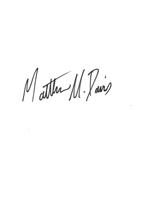
Corrugated box shipments, often cited as a leading indicator of economic activity, could be offering some good news for box producers. The Association of American Railroads (AAR) tracks pulp and paper products (P&PP) as a category of rail originations. This may be the most current indicator of box demand, since roughly 60% of containerboard is shipped by rail. AAR aggregates and reports weekly data from North American rail operators. Each month, Green Markets gathers the figures to assess changes in P&PP originations. CSX, the largest volume shipper of P&PP, saw a 6.9% decrease in shipments in the segment in 2023 (Figure 1). For the corrugated packaging industry, shipments fell 5.1%.

Source: CSX
Source: Fibre Box Association
Source: Association of
Shipment originations, along with our assessments of sentiment among box producers, help us better understand trends in industry demand. For example, it would be odd for box demand to spike 5% without a corresponding increase in rail shipments.
In 2023, cumulative box shipments bottomed out with April’s 14% plunge (Figure 2). After Week 18, they only got better. Yet there was an 18-week lag before originations reflected the trend. P&PP rail improvements became visible starting in Week 36, when originations were down 5.8% and started climbing to finish the year at minus 3.3%.
The lag is likely due to how quickly box shipments slumped relative to a year earlier. Shipments slid nearly 10% through April, a sign that some box plants probably held more paper than desired and needed to draw down inventory. Starting in Week 13, average monthly rail shipments began to drop about 7%. In weeks 27–30, they fell 8.5% from the first four weeks of the year.
In the first quarter of 2024, P&PP rail shipments continued to trail the 2023 period’s before picking up heading into the second quarter (Figure 3). Combined with other economic reports, there’s reason to think box shipments may be rebounding, as well. The March Manufacturing Purchasing Managers’ Index came in at 50.3, and the New Order Index was at 51.4, while corrugated boxes showed up among commodities that were increasing in price. Together, the data point to a potential resumption of industry growth after 16 months of contraction.

Ryan Fox is a corrugated market analyst at Green Markets, a Bloomberg company.
AICC, through its membership in the Small Business Legislative Council, monitors legislative developments in Washington, D.C., and from time to time, there’s something to report to you, our members. First on the list is a move in the U.S. House of Representatives and U.S. Senate to delay the implementation of the Corporate Transparency Act (CTA). I wrote about the CTA in September (Legislative Report, BoxScore, September/ October 2023). In that article, I wrote, quoting the American Bar Association, that “at its core, the CTA is a mechanism to deal with issues related to ‘dirty money’—i.e., guarding against money laundering, terrorism financing, and other forms of illegal financing—as well as the general lack of beneficial owner (i.e., ‘true owner’) information with respect to many domestic entity structures ... The CTA was born of the view that the availability of beneficial ownership information is a crucial tool in the fight against tax evasion, money laundering, corruption, terrorist financing, and other financial crimes.”
I dare say that if anyone in our industry were to be found guilty of violating the law, it’s highly unlikely the crimes listed here would be among them. The law was slated to go into effect on January 1, 2024, but the U.S. Court of Appeals for the Northern District of Alabama on March 5, 2024, ruled in a lawsuit brought by the National Small Business Association (NSBA; National Small Business Association v. Yellen) that the CTA exceeded the U.S. Constitution’s enumerated powers and was, therefore, unconstitutional. Yet the ruling’s application was strangely limited, giving relief only to the members of the

principal plaintiff, the NSBA. All other businesses would still be subject to the law’s deadlines.
On March 19, 2024, AICC joined 125 other business and industry associations in appealing to the House and Senate to delay the effective date of the law to allow the NSBA suit to make its way through the judicial process and to be consistent with the original congressional intent on giving businesses a full two years to learn about and comply with its reporting requirements. And what are those requirements? Businesses will have to report their beneficial ownership annually to the Financial Crimes Enforcement Network. “Beneficial ownership” means anyone who has a financial interest in the business, which in the eyes of many critics is an invasion of privacy and a precursor to greater
reporting demands on the business community going forward. We hope sound reason will prevail in this discussion and the voices of 125 business and industry associations are heeded. The two pieces of legislation that would extend this bill’s deadlines are S. 3625 and H.R. 5119. Urge your representatives and senators now to support them. Go to www.house.gov or www. senate.gov to find your congressional representatives. Or call the U.S. Capitol switchboard at 202-224-3121.

Eric Elgin is owner of Oklahoma Interpak and chairman of AICC’s Government Affairs subcommittee. He can be reached at 918-687-1681 or eric@okinterpak.com




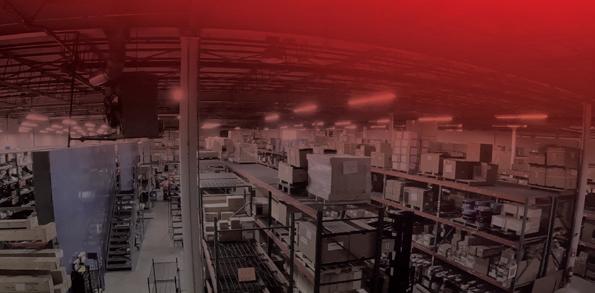
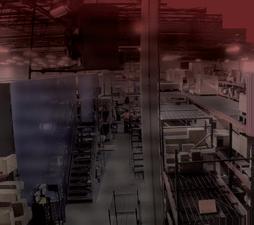
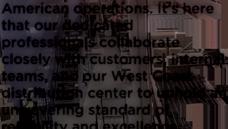

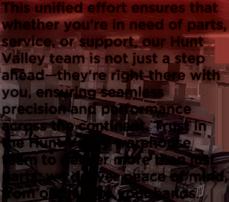
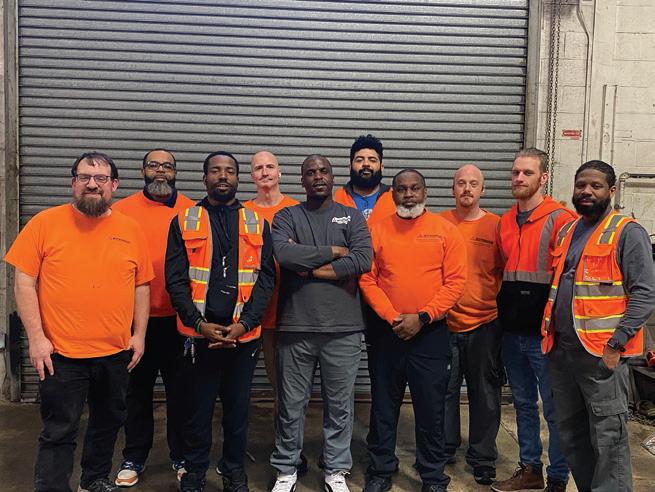
FILTRONA TAPES INC.
SARAH RUTLAND
Market Development Manager
1625 Ashton Park Dr. Colonial Heights, VA 23834
804-518-1067
www.filtrona.com
ALLIANTGROUP
LENA DZIECHOWSKI
Associate
3009 Post Oak Blvd., Suite 2000 Houston, TX 77056
713-877-9600 www.alliantgroup.com
OPUS PACKAGING GROUP, INC.
LOUIS SICILIA
Chief Financial Officer 6995 Southbelt Dr. Caledonia, MI 49316 833-526-4445 www.opuspkg.com
ERHARDT+LEIMER INC.
DENI MOHAMMAD
350 Tucapau Rd. Duncan, SC 29334
864-486-3000 www.erhardt-leimer.com
HARPERLOVE ADHESIVES
JEFFREY BUCHANAN
Director of Sales and Market Development 11101 Westlake Dr. Charlotte, NC 28273
704-588-1350 www.harperlove.com
LARSON PACKAGING COMPANY
SCOTT GRILLS
Chief Operating Officer 280 Cypress Lane El Cojon, CA 92020
619-579-7166
www.larsonpkg.com
SUPPLYONE, INC.
GEORGE VAN KULA
Chief Administrative Officer and General Counsel 11 Campus Blvd., Suite 150 Newtown Square, PA 19073 484-582-5005
www.supplyone.com




















The AICC 2024 Spring Meeting and 50th Anniversary Celebration concluded with resounding success, marking a historic milestone for AICC. Held in the scenic backdrop of Palm Desert, California, the event brought together 850 industry leaders, emerging talent, and esteemed guests for a memorable occasion of learning, networking, and celebration.
The extravaganza featured myriad sessions, speakers, and activities, offering attendees invaluable insights into industry trends, essential information, and networking opportunities. Event highlights included the commemoration of AICC’s 50th Anniversary, the 10th Annual Independents’ Cup Charity Golf Tournament, and 10th Anniversary of the Emerging Leader program, marking a decade of growth and innovation.
The enthusiasm of attendees was palpable throughout the event. “We are thrilled the AICC 2024 Spring Meeting and 50th Anniversary Celebration was such a high note this year,” says Matt Davis, president of Packaging Express and AICC chairman. “This event provided a platform for connecting with new friends and old, having meaningful discussions, and it also allowed us to honor the legacy of AICC while looking forward to a future of continued growth and success.”
From the moment attendees entered the event space, they were steeped in AICC history. They enjoyed a Walk of Fame, with past U.S. board chairs remembered on stars on the floor, an

AICC Board Chair Matt Davis of Packaging Express and AICC President Mike D’Angelo recreate the moment from the first AICC meeting of breaking one stick but unable to break a bundle of them. This highlights that independents are still stronger together.

















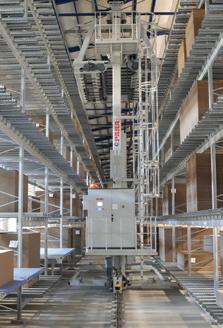



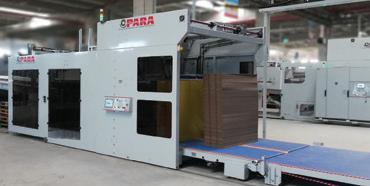
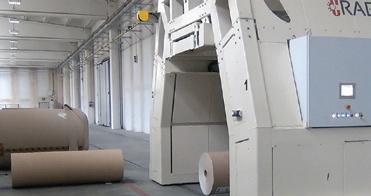



8-foot timeline of AICC’s history, and signs honoring the accomplishments of Hall of Fame recipients, AICC Canada and México past board chairs, safe shop winners, and many others who have been part of AICC’s history.
The meeting kicked off with the Sales Managers Forum, a dynamic training session designed exclusively for sales managers in the corrugated manufacturing industry. Led by industry experts John Ballentine of the University of Arkansas and Trent Halasek of Akers Packaging Service Group, the forum delved deeply into the financial implications of sales decisions, equipping attendees with valuable skills to drive value-based choices.
The event featured insightful sessions on hot industry topics, including Sarah Meiburg of the Paper & Packaging Board sharing tools and insights on selling sustainability and Derek Mahlburg of RISI offering an economic outlook and emerging trends. Both sessions provided attendees with a comprehensive understanding of the challenges and opportunities facing the industry today.
Tim Connell of A.G. Stacker moderated a panel with AICC experts Ralph Young, AICC corrugated technical advisor; Doug Friel, risk management advisor at JKJ; and Jeff Putt of Deline Box and the AICC AI & Technology Committee chair. They answered members’ technical questions and offered resources to help boxmakers be more efficient and productive.

Members dance long into the night and truly have a celebration to remember.
AICC is grateful to the sponsors who helped make the Spring Meeting a success:
PREMIER 50 th
• Bradford Co.
• Flint Group
• Haire
PREMIER PLATINUM
• Domtar Packaging
PREMIER GOLD
• eProductivity Software
• A.G. Stacker
• SUN Automation
• A.G. Stacker
• Bobst
• JB Machinery
• Pamarco
• Quest7
• A.G. Stacker
• Pacificolor
• Göpfert
ADDITIONAL SPRING MEETING SPONSORS INCLUDE:
• Oklahoma Interpak
• HP
• Kao Collins
• Geo. M. Martin Co.
• Alliance Machine Systems
• Bay Cities
• Stafford Corrugated Products
• Kolbus America
• Mitsubishi Heavy Industries
• Global Boxmachine
• EFI
• Arco Murray
• Bradford Company
• Huston Patterson
• Lewisburg Printing Co.
• Dusobox
• Amtech
hairegroup.com



Jerry Frisch of Wasatch Container gave a heartwarming and entertaining presentation about how his company began and grew and offered advice to the next generation of leaders.
Moderators Joe Morelli of Huston Patterson and Lewisburg Printing Co. and Jeff Pallini of Fosber America Inc. led an industry panel with Chad Wagner of Peachtree Packaging; Larry and Richard Grossbard of President Container; and Bill, Jim, and Andrew Akers of Akers Packaging. The panelists discussed family dynamics, industry challenges, and their vision of the future.
Ron Sasine of Hudson Windsor took a deep dive into consumer purchasing behavior, changes in distribution, and the differences between what retailers say they need and what the industry thinks they need.
Keynote speaker Pippa Malmgren, former special assistant to former President George W. Bush and authority on geopolitical, economic, and technological trends, took attendees into the future with her presentation. She described the turbulence she sees coming and the opportunities on the horizon and discussed a different form of globalization, the new space race, and the speed of new technology.
Henry Winkler, aka “The Fonz,” Emmy award-winning actor, author, director, and producer, closed the meeting with the enthralling story of his youth, how he got into acting, and how discovering his dyslexia later in life put many of his experiences into a new context. He was called dumb by his parents, who did not support his dream of acting, but he never let their words stop him; they only motivated him to be and do more. He shared emotional stories with a humorous twist to captivate the audience before taking questions and signing his latest book for attendees. New members and first-time attendees were treated to a special networking reception with their AICC ambassadors,
who helped them navigate their first meeting and make new connections.
The celebration’s highlight was the 50th Anniversary Dinner, where attendees dressed in their finest. The room was beautifully decorated with centerpieces created by Bay Cities, glowing trees, and stars covering the room. Many attendees took advantage of a 360-degree photo booth to memorialize the evening. They also watched a video tribute to AICC’s history and future. Bringing in the golden age of Palm Springs for AICC’s golden anniversary, attendees watched a Rat Pack tribute show. They then danced the night away to lively big-band music, providing the perfect finale to a memorable evening.
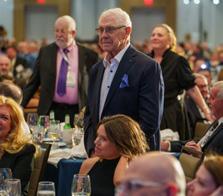
• 50 years: Automated Conveyor Systems
• 40 years: Packaging-Atlanta Corp. and Alliance Machine Systems
AICC thanks BHS, WestRock, and Domino for their support in creating the 50th anniversary video shared during the celebration. “Words cannot express how grateful I am to past AICC members for 50 years of memories and to current members who made the celebration in Palm Desert a new and fitting memory. AICC is clearly ready to support its members for the next 50 years,” says AICC President Mike D’Angelo.
During the meeting, AICC also celebrated the milestones of its members, recognizing the following companies for their years of continuous operation:
• 110 years: Utah PaperBox
• 100 years: Bradford Co. and Standard Printing Co.
• 70 years: Global Boxmachine
• 65 years: Lonestar Container
• 60 years: Corrugated Supplies Co.
“As we reflect on the success of the AICC 2024 Spring Meeting and 50th Anniversary Celebration, we are grateful for the continued support and participation of our members, sponsors, and industry partners,” says Terri-Lynn Levesque of Royal Containers, chair of the AICC Convention Content Committee. “This event served as a powerful reminder of the significant influence AICC has had on our industry. We will be talking about our time together in Palm Desert for the next 50 years. We look forward to building on this momentum and shaping the future of the independent packaging industry together.”
Videos of many sessions are available to attendees upon request. Contact Laura Mihalick at lmihalick@AICCbox.org for more information.
AICC members will come together again for SuperCorrExpo, September 9–12, 2024, in Orlando.
For more information about upcoming events, visit www.AICCbox.org/calendar.
Throughout the Spring Meeting, attendees participated in various activities, including the Independents’ Cup Charity Golf Tournament, where they tested their skills on championship courses against the backdrop of the Santa Rosa Mountains in California. The tournament not only provided a platform for friendly competition but also supported a charitable cause. The tournament raised $15,000 for the Foundation for Packaging Education.
“We are thrilled that the Foundation for Packaging Education was the beneficiary of the Independents’ Cup Charity Golf Tournament,” says Gene Marino, president of Akers Packaging Service Group and board chair of the Foundation for Packaging Education. “The tournament not only raises funds to benefit our educational programming but also showcases the camaraderie within our industry.”
Major Sponsor
• Hood Container Caddies
• Schwarz Partners
ADDITIONAL GOLF SPONSORS INCLUDED:
• BHS
• Equipment Finance Corp.
• EMBA
• Bradford Co.
• Fosber
• BCM Inks
• Bobst
• Cuir
• Litho Press
• Flint Group
• Crossroads Paper
• Isowa America
• EAM MOSCA
First Place—Palm Course
• Bobby Atkinson, GAPCO | Gulf Atlantic Packaging
• Cody Bryant, A.G. Stacker
• Colin Moynihan, Columbia Container
• Tom Murphy, Reliable Container
First Place—Valley Course
• William Berg, Menasha Packaging
• Brant Dixon, A.G. Stacker
• Brian Kentopp, Topp Corrugated Products
• Bryan Rabb, Rabb Corrugated
• Engineered Recycling Systems
• Huston Patterson
• Lewisburg Printing Co.
• A.G. Stacker
• Akers Packaging Service Group
• Alliance Machine Systems
• American Corrugated Machine
• Atlantic Packaging Products
• BW Papersystems
• Clean Print USA
• Dicar
• EAM Mosca
• Isowa America

Gift Cards
• Bobst
• Jamestown Container Cos.
• M&T Capital Leasing
• McLean Packaging
• Pacificolor
• Pamarco
• Philipp Lithographing
• Quantum Ink
• Royal Containers Ltd.
• Standard Printing Co.
• Standfast Group
• Two10 Technologies
• Valco Melton
• Wasatch Container





Kiwiplan has provided robust, mission-critical software solutions for the corrugated and packaging industry for more than 30 years. Kiwiplan provides powerful tools and functionality to drive improvements, enhance productivity, and improve quality for packaging manufacturers of all sizes.
Abaca Systems business management suite puts optimum performance at the tips of your fingers. Our flexibility enables our work with corrugated, paper related, and distribution & maintenance companies of all sizes. Whatever your operation, Abaca system is designed to meet your complex requirements.
Drive revenue growth with Advantzware, a scalable and customizable ERP solution tailored to fit midmarket packaging manufacturers. With a centralized database and seamless integration with optional modules, Advantzware ERP improves operational efficiency and maximizes employee productivity.

Over the past 15 years, we have published several AskRalph blog posts and BoxScore articles on this often forgotten significant variable to box compression/box performance, which is four-point bending stiffness . To review those pieces, you can go to the search bar on AICC NOW, NOW.AICCbox.org, and enter this subject or contact me directly.
The definition in the Technical Association of the Pulp and Paper Industry T 836 states that “bending stiffness measurements of the combined board when used with the edge crush test and box dimensions can accurately predict the top-to-bottom compression strength of a box.” McKee’s short formula makes an estimation of this property by using the caliper of the combined board. As we will see in the example below, the equal compression strength is improved by moving from a 69/23C/69 combination to 35/23E/35/23N/35.
We have known of the edge crush test (ECT) inclusion for almost 35 years now, but we often ignore or never understood the other major characteristic of corrugated in building box performance. This seldom considered property, while not as significant as ECT, still has a contribution to top-to-bottom compression—also,
but not discussed here, the measurement of torsional stiffness as determined by dynamic stiffness tester (DST) instrumentation. This is not an issue of virgin/ semichemical fiber versus recycled fiber as one would obtain the same results.

My associate, Tom Weber, and I led a webinar in June 2022 titled “Testing Requirements to Guarantee Board Strength” that covered many physical properties of corrugated, folding carton, and rigid box. One of these properties was four-point bending stiffness for corrugated and taper stiffness for paperboards. It needs to be emphasized that the bulging resistance of the corrugated vertical side panels has an impact on box compression.
A third consideration of the impact of transport on the corrugated box is flexing or twisting. The way to measure this and the contribution of proper combining and converting is the use of a DST. More than 70 are in use in North America but very few among the independent portion of the corrugated industry. What do the big companies know?
The program above was a follow-up to a major 2018 national meeting presentation titled “Fluted vs. Paperboard,” with a panel discussion with converting experts. After this faceto-face presentation, we published an extensive white paper that includes a chart
of some bending stiffness values for a few combined board combinations.
This particular member combiner and converter does not have access to lower substance linerboards like 29# or 21#, so we were not able to run other permutations. Additional resources are available at AICC, including expected values of containerboards such as SCT and CFC, to assist you in coming up with multiple options in reengineering the corrugated structure and box.
Although the environmental sustainability savings is less than 10% fiber reduction, the financial sustainability savings is 25%. What would your customer benefit from most? Consider the marketing advantage! Not many have all these flutes and options, but some do, and you can do something with small-flute double-wall and low-substance linerboard and medium.

Ralph Young is the principal of Alternative Paper Solutions and is AICC’s technical advisor. Contact Ralph directly about technical issues that impact our industry at askralph@AICCbox.org
An award-winning printing line for corrugated
An award-winning modular printing solution Up to 3 flexo units + single pass inkjet + rotary die cutter




The low-capex option to stepinto single-pass hybrid
With Kento Hybrid’s modular approach, you get the power to decide how and when to scale up your corrugated printing operation, starting with a price tag similar to a multi-pass digital printer.
Flexo printing for solid backgrounds, white ink, special colors
Digital printing for high-quality images and personalization
Rotary die cutting for increased overall equipment efficiency





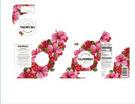

Join us at Super CorrExpobooth #2770, September 2024
We are corrugated

download a brochure ask for a live demo


After receiving several member inquiries about plant safety inspections, the use of a third party to do so objectively, and preparation for an Occupational Safety and Health Administration (OSHA) inspection, I thought I would share below what I orchestrated while leading a privately held folding carton and blister card company in Northeast Ohio.
We expected an unannounced OSHA inspection due to a workplace injury that resulted in a partial finger amputation from a drug-impaired employee, who was treated and then summarily terminated under our company drug testing for cause policy.
The inspection was performed based on the Safety Plus program, a free Council of Smaller Enterprises service to small Ohio-based businesses. This report details inspection findings and a list of recommendations. It also provides examples of safety and health hazards for future employee trainings and demonstrates what you could possibly expect, in the form of violations, after an on-site OSHA inspection.
The identified conditions in this report are those that might be addressed during an OSHA inspection and may be considered safety hazards. This safety inspection was performed as a service and is intended to be used as a tool to improve your company’s health and safety.
OSHA inspections are initiated by one of the following and are prioritized in the order presented:
• Imminent danger
• Catastrophes and fatal accidents
• Employee complaints
• Programmed high-hazard inspections
• Follow-up inspections
Of these inspection priorities, our industry would be most susceptible to employee complaints. Sometimes, disgruntled employees contact OSHA after a discordant separation.
1. Emergency Action Plan
• There is an emergency action plan in place.
2. Material Handling and Storage
• Production paper rolls were mostly stored properly in a horizontal position.
• Some production paper rolls were stored in a vertical position with no roll chocks to prevent the rolls from moving and potentially causing a crushing injury.
• The facility flammables storage room was appropriately maintained and included sill construction, an Ansul system, bonded containers, and a fire door.
• The ink room and flammables storage room were equipped with a combustible gas (LEL monitor) and a Magnehelic pressure gauge.
• The maintenance room was cluttered and difficult to get around. In addition, a large number of flammables were stored on shelves, not in a flammables cabinet.
3. Fire Prevention and Protection
• Fire extinguishers are inspected and tagged annually.
• Fire extinguishers are also inspected monthly.
4. Hazard Communication
• A hazard communication program is implemented and includes Globally Harmonized System of
Classification and Labeling of Chemicals (GHS) requirements and the proper labeling of secondary containers.
• Material data safety sheets (also referred to as safety data sheets) were available for review.
5. Machine Guarding
• Multiple machine-guarding deficiencies were observed.
• Potential pinch points were observed.
• The guards are insufficient; worker can reach under and/or around the device.
• Foot pedal must be independent of the two-handed operation.
• Multiple pinch points on the folder were observed.
• The guards are compromised.
• Gates provide some protection, but much of the folder has open pinch points.
6. Forklifts
• Operators have been trained, certified, and evaluated per OSHA standards.
• Manuals are not present on all of the forklifts.
• Pre-use inspections are not being performed.
• Paper roll clamp attachment is not reflected on the forklift data plate.
• Propane fuel tanks are not properly secured to the vehicles.
• This inspector observed a truck pull into the loading dock. The leveler was placed, and the employee began loading with a motorized pallet jack without the trailer wheels being chocked. The employee stated they had training within the past three months.
• Open hatches present thermal hazard. If the hatch must remain open, install a screen or cage.
7. Electrical
• Electrical panel not labeled with appropriate arc-flash personal protection equipment (PPE) per National Fire Protection Association (NFPA) 70E requirements.
• Damaged extension cord should be taken out of service.
• Uncovered electric junction box has energized conductors outside the box.
8. Confined Space
• A confined space assessment has not been done and any confined spaces labeled as such.
9. First Aid
• Eyewash stations must be properly maintained and inspected on a weekly basis.
• Temporary eyewash solution was expired and must be replaced to prevent added injury.
10. Miscellaneous
• Abrasive wheel grinder is not properly guarded or maintained.
• It appears voluntary use of ear protection is allowed. However, this inspector concluded noise monitoring should be performed based on a noncalibrated sample.
MATERIAL HANDLING AND STORAGE
• Provide shocks for vertically stored or moved paper rolls.
• Continue the policies relative to the flammables storage room.
• Develop a housekeeping plan for the maintenance area and provide a flammables cabinet for storage.
HAZARD COMMUNICATION
• Develop and implement a written hazard communication program, which includes GHS updates.
• Enforce the proper labeling of secondary containers.
• Perform a complete machineguarding assessment and properly guard all machines.
• Acquire forklift manuals and keep them on the forklifts.
• Ensure daily inspections are being performed, and the inspections are documented and retained for record-keeping purposes.
• Contact the forklift manufacturer and get approval and updated data plate for the paper roll clamp attachment.
• Retrain or refresh forklift operators on the OSHA requirements for powered industrial truck operators, especially related to the refueling of propane-powered vehicles and the loading of semitrailers and rail cars.
• Mark electrical panels with appropriate arc-flash PPE per NFPA 70E.
• Remove the damaged extension cord from service.
• Cover or eliminate the open electric junction box.
• Perform a confined space assessment and label any spaces identified as such.
• Develop and implement a weekly eyewash station inspection and maintenance program.
• Replace the expired eyewash solution.
• Adjust the guards for the abrasive wheel grinder to the correct distances—one-eighth of an inch from the wheel for the tool rest and one-quarter inch for the tongue guard.
• Perform noise monitoring to ensure the facility falls under the OSHA
85dB trigger point for hearing protection program.
This inspection focused primarily on hazards identified on the day of the inspection and is not intended to be a comprehensive review of your overall annual health and safety program.
A total of eight (plus the number of machines on-site with improper guarding) potentially serious violations had been found. A serious violation is one in which there is substantial probability that death or serious physical harm could result and the employer knew, or should have known, of the hazard. A penalty of up to $7,000 for each violation is proposed.
Other than serious violations are those that have a direct relationship to job safety and health but probably would not cause death or serious physical harm. A proposed penalty of up to $7,000 for each violation is discretionary. A typical other than serious violation penalty would be $1,000 or less.
This report was completed to assist my company in understanding the types of citations we could have received from an OSHA inspection, which indeed did take place two months later as luck would have it. (Note: This report in no way reflects the opinions or positions of OSHA.)
I hope sharing this inspection report stimulates some of our readership to evaluate your plant safety programs and processes to make certain significant and long-lasting improvements are continually being made, just as you all do to your quality processes for all employees and clients involved.
Hats off to a safe and productive second half of 2024!

Tom Weber is president of WeberSource LLC and is AICC’s folding carton and rigid box technical advisor. Contact Tom directly at asktom@AICCbox.org
Lead generation is the cornerstone of sales growth. While there are often additional growth opportunities with current customers, the potential is finite, while the pool of new prospects is immense. Implementing lead generation strategies for new business development allows for scalability and exponential growth that can’t be accomplished through the current customer base alone. However, not all leads are created equal, nor should they be given equal attention. So, what is a lead?
The term “lead” by itself is extremely broad. When referring to sales and marketing, a dictionary definition of lead is “a person or thing that may be useful, especially a potential customer or business opportunity.” The word “may” is the key here. It is the role of the sales and marketing teams to vet them and move them through the sales pipeline.
First, let’s be clear about what a lead is not. Many unscrupulous companies are willing to sell you hundreds or thousands of leads, and most will be garbage. Lists of companies or people with contact information are not leads—even if the North American Industry Classification System codes classify them in an industry that uses your packaging or products. If you compile a list of contacts from companies that fit your target market profile—they match company size, spending potential, product mix, etc.—these are still considered prospects, not leads. They don’t become leads until they have demonstrated a desire to learn more or explicitly stated they need your product or service.

Leads can be broken down into two categories: marketing leads and sales-qualified leads.
A marketing lead is a prospect that has shown interest in your product. These are generally generated when they engage with your content through inbound marketing, social media, trade shows, or other events. This is someone who has demonstrated interest by performing actions such as submitting contact information, signing up for a webinar or newsletter, downloading materials, or repeatedly visiting your website.
A lot of junk can come through your website and online forms, so some level of investigation may be needed to weed out spammers, competitors, students looking
for information, and others with no potential to become a sale.
The primary goal with marketing leads is to engage and educate them, gradually moving them down the sales funnel until they are ready for a direct sales approach. Your marketing team may nurture marketing leads through the sales cycle by providing information relevant to where they are in the buying journey. This is often done through email campaigns, which may include lead scoring. These leads are not ready to buy and must be further vetted to ensure they align with your target market profile.
Sales-qualified leads are further down the sales funnel. Once a marketing lead has been further vetted to fit your target







ost compl print portf rrugate
The most The most complete digital print portfolio for the corrugate for the corrugated industry






market profile and has demonstrated an interest in speaking with your sales team, they become a sales-qualified lead. Often, prospects or market-qualified leads become sales-qualified leads through outbound calling. An inside sales rep calls the prospect and, during the course of conversations, uncovers answers to predefined qualifying questions that ensure they are a fit. If the person is interested and has been vetted as a fit through the qualifying questions, the inside sales rep sets up a meeting with an outside sales team member. Outside sales discusses the lead’s needs in detail, offers solutions, and moves them toward the quoting phase. In some cases, the journey from marketing lead to sales-qualified lead can happen quickly; in other cases, it might take much longer. The primary goal of sales-qualified leads is to convert them into customers. Since they are ready and willing to discuss their challenges and your solutions, the sales team focuses on direct engagement and closing the sales.
Understanding the difference between the two types of leads is crucial for several reasons directly impacting the efficiency and success of sales and marketing strategies within your organization. Those reasons are as follows:
• Resource optimization: Understanding the difference allows for better resource allocation between the sales and marketing teams and ensures sales teams focus on tasks that lead to closing sales.
• Improved sales cycle efficiency: When the sales team focuses on qualified sales leads, the sales process becomes more streamlined, potentially shortening the sales cycle and increasing the chances of closing more sales.
• Enhanced customer experience: Understanding the difference allows you to provide a personalized
experience. Marketing leads may require more educational information to move them through the funnel, while sales-qualified leads may benefit from targeted solutionoriented communication.
• Increase in conversion rates: Sales-qualified leads are further along in the buying process, so allowing your sales team to focus solely on these leads will increase conversions. When the sales team’s time is split or they are chasing unqualified leads, opportunities to close may be lost.
• Better collaboration between sales and marketing: It’s well known that sales and marketing often clash. By differentiating between marketing leads and sales leads, both teams will be on the same page regarding their roles in the lead generation and nurturing processes.
Without a strategic approach to converting marketing leads to sales-qualified leads, you may face low conversion rates, inefficient use of resources, poor lead quality, misalignment between sales and marketing, and lost revenue opportunities.
A repeatable process incorporating a customer relationship management (CRM) tool and a marketing automation system combines foundational elements for consistently converting marketing leads to sales-qualified leads. A repeatable process ensures that every lead is nurtured and assessed through a consistent framework. This consistency is critical to reliably moving leads through the sales funnel, as it eliminates guesswork and variability that can lead to leads slipping through the cracks.
A process streamlines operations, creating greater efficiency while allowing you to scale your efforts up or down as needed. A consistent process makes measuring performance easier and enables you to
identify bottlenecks or trouble spots and implement continual optimization of the lead-conversion process.
A CRM system centralizes all lead and customer data, which is crucial for maintaining an up-to-date understanding of each lead’s status and interactions. CRM and marketing automation tools enable sophisticated segmentation of leads based on various criteria that support highly personalized marketing and sales outreach, increasing the relevance and effectiveness of communications and allowing sales marketing to provide information relevant to where they are in the buying cycle. With a marketing automation tool, the outreach can be automated, creating greater efficiency in the process. Plus, both tools provide valuable analytics and reporting features to allow teams to track conversion rates, understand lead behavior, and adjust the process when required. Understanding the difference between marketing leads and sales-qualified leads is essential for optimizing your sales and marketing efforts. A defined process and proper tools provide the structure, efficiency, personalization, and insights necessary to nurture leads effectively, prioritize sales efforts, and ultimately close more deals. By leveraging technology and a systematic approach, you can enhance your lead-conversion capabilities, driving growth and maximizing the return on investment.

Todd M. Zielinski is managing director and CEO at Athena SWC LLC. He can be reached at 716-250-5547 or tzielinski@athenaswc.com

Lisa Benson is senior marketing content consultant at Athena SWC LLC. She can be reached at lbenson@athenaswc.com


















After a long, cold winter—though we did get an early spring this year since the groundhog didn’t see his shadow—summer days can’t get here fast enough. Breaking out the Hawaiian shirts, sipping refreshing cocktails on the porch, and indulging in our favorite pint of ice cream as a reward for mowing the grass are checklist items we can’t wait to begin checking off. Fortunately for us, Memorial Day—the unofficial kickoff to those glorious sunny days—is right around the corner. With that in mind, you’d best believe we got ourselves ready for another trip to the store to see what brands would wow us this year with their summer-inspired designs.
Since we both love to travel and explore the world around us, the women’s travel kit below by Navajo Inc. caught our eyes first. For both of us, this is convenience at its finest—combining all the items we need to stay fresh and clean for a journey to, let’s say, Cabo. There’s even a bath puff with body wash to get the lather you deserve rather than scrubbing with the
hotel’s complimentary soap bars (though we are divided on this point—Alli loves her some soap bars). As an added bonus, everything in this resealable bag is Transportation Security Administrationcompliant, alleviating our anxiety of being pulled out of line due to a large mouthwash bottle that somehow made its way into our luggage. And they even have a version for men (also below) that includes a toothbrush, toothpaste, and mouthwash—a full set of toiletries to keep you from feeling too travel-worn on your summer adventures.
As we turned the corner, we ran smack into an endcap display that was unabashed in its summer days agenda. You can’t get by without sun protection,
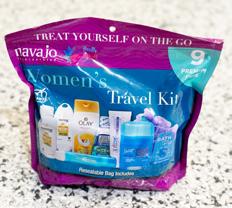
and this display of sunscreen helps shoppers prepare for the upcoming season of vacations, barbecues in the sweet heat,

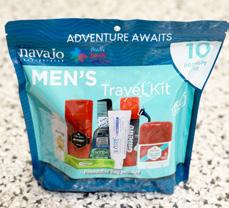
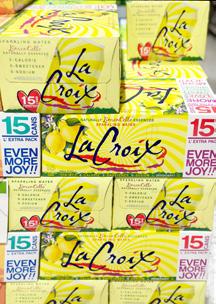
and the many get-outside-while-you-can activities. This endcap not only has a wide array of sunscreen options but also comes with fantastic sun care advice and a chart describing which SPF is right for you. This simple yet effective display was able to incorporate information consumers need to know directly into its in-store marketing materials—pretty cool, huh?
The next product (above left) that grabbed our attention, LimonCello LaCroix, seemed to transport us to another country—we must have been thinking about sipping a boozy, citrusy beverage on the Amalfi Coast of Italy—a girl can dream, right? But LaCroix, with its effervescence and refreshing aftertaste, gives us a version of that experience minus all the sugar, alcohol, and travel expense as we sip this beverage to our heart’s content in our version of Italy—under a striped
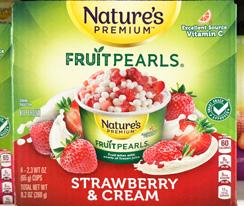
umbrella at the neighborhood pool. (Sidenote: We do hope Italy is on the itinerary one day.) The bold yellow color of the packaging— can and secondary container—and the use of lemon imagery radiate energy and optimism, much like the possibilities of a summer day. Finally, we strolled through the chilly frozen foods section, where we came upon a product we’ve never seen before— Nature’s Premium Strawberry & Cream Fruit Pearls. This healthier dessert alternative (above right) delivers innovation in a cryogenically frozen grab-and-go format. It’s not a completely new concept to us, but it pulls us in because it was previously found only at baseball games or concerts (Dippin’ Dots, anyone?). The package design offers a glimpse of one of the quintessential pleasures of summer— delicious, ripe strawberries swirled with cream. The vibrant red and green colors rounding out the background on the package are important because it’s been found that highly saturated colors boost perception of stimulus intensity. This means that a highly saturated packaging
color can lead consumers to have a stronger experience of the product and/ or taste it more intensely. We’ve yet to try this product, but trust that when we do, we will be doing so with the music turned way up and our toes in the sand. This trip was another fun break from our normal, run-of-the-mill shopping experience, and we had a blast searching for packaging that embodies summer with its vibrant colors, nostalgic images, and memorable design layouts. But what do you think? Did these brands successfully leverage a seasonal element into their packaged products? Let us know by emailing julie@packagingschool.com or alli@packagingschool.com.

Julie Rice Suggs, Ph.D., is academic director at the Packaging School. She can be reached at 330-774-8542 or julie@packagingschool.com.

Alli Keigley is production coordinator at the Packaging School. She can be reached at alli@packagingschool.com.
Imiss the idea of polite society. As a child of the 1960s, I have witnessed ever-decreasing expectations of decency, respect for differences, and responsibility for individual behavior. If this deterioration can be slowed, then it is incumbent upon people of influence to model respect and self-control. In leading and managing our companies, we have the opportunity, if not responsibility, to create a polite society at work. As the owner of one of the most successful businesses in our industry said, “We are smart, we are highly competitive, and we usually win. Now I want us to be kind.”
The current rules of engagement on the highways, on social media, and in our relationships have become increasingly volatile and reactive. We may not accept that there is a new standard of behavior, but neither are we shocked when we see people who “don’t know how to behave.” Counting Karens may soon replace the old Punch Buggy game.
Perhaps it is possible for leaders of any stripe to raise the expectation by sharing models for responsibility and respect within our scope of influence. I say perhaps because it comforts me to believe that ignorance drives this bad behavior. If they know better and they are still acting this way, then I must forfeit hope.
One such model that might easily be deployed in the workplace is taken out of the substance abuse recovery curriculum. It may be utilized to de-escalate a conflict between employees or as a description of your own process. The conversation might go like this: “You seem pretty upset. Let’s talk this through.” Having eddied out, the leader might explain that they are working on being more proactive than reactive in communication.

I choose this particular tool because, like most of us, I have overreacted with incomplete information and complete emotion, with the result of escalating conflict and being foolish. To avoid repeating this offense, I ask myself these questions: Who am I upset with? Who was/is the object of my resentment?
This could be a person, an institution, a political party, or a particular group. Prior to asking this question, I may believe I am upset about everything. I might default to generalizations (“Everything is ruined,” or “Nothing is going right”). The simple act of stating what I am specifically troubled by will focus the issue. Then it is a problem defined.
The cause. What specific action did that person take that hurt me? This further defines the event. It also might be an opportunity to explore alternative explanations for the event. Granted, if a person ran over my foot, then my pain is not diminished by their motivation. This may, however, create the opportunity to see the event from a different perspective. The ability to see things from another
perspective is a prerequisite to the respect and self-control in a relationship that is my ambition. Without perspective, the population degrades into good people like me and bad people like you. It is a simple way to live on the road to chaos.
The effect. What effect did the action have on my life? What did I feel? When I explore how I actually feel in reference to the other person’s actions, I must start by being brutally honest, even if it exposes an overreaction on my part. Only after being honest with myself about the feeling can I take the next step. Was my reaction in proportion to the offensive actions of the other person? If it was a level 10 response to a level five action, then why do I believe this occurred?
The damage. What harm came from the action of the other person? What damage was developed as a result of the effect I listed above? Has it changed my belief about myself or the workplace? Do I believe it is beyond repair?
My part. What part of the resentment am I responsible for? How did my behavior contribute, even in a small way,
to the problem? If I return to the example of someone having run over my foot, then I may need to take responsibility for my own lapse in attention or my decision not to wear steel toe boots on that day. Even if I am a victim, I can acknowledge my own choices. Even if it is determined that my foot-targeter did so with malice aforethought, I will be better equipped to avoid a recurrence.
Conclusion
These five questions might be answered alone or in dialogue. In either case, the result is often a reduction in the scope and effect of the event in question. Company culture models many tools for continuous improvement of quality regarding products and service. This
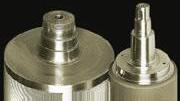




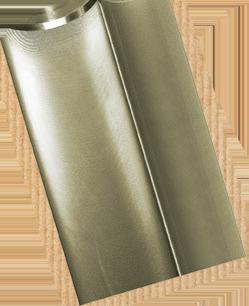











KraftCoat Opaque White Coating This innovative solution surpasses the conventional mottled white paper by leaps and bounds. Featuring unique attributes essential for printing vivid graphics, KraftCoat ensures unparalleled color fidelity and performance on recycled kraft materials. Its superior coverage lays the perfect foundation for vibrant colors, easily capturing attention, whether applied through digital, lithographic, or flexographic printing methods. Embrace the future of recycled kraft liner enhancements with KraftCoat Opaque White Coating, where brilliance meets clarity and innovation. Contact us to discover more!






AICC held its first Road Show in March at Bay Cities, an active member of the AICC community, in Pico Rivera, California. The event attracted approximately 30 attendees from five companies, all eager to learn about the myriad benefits available to AICC members.
The Road Show features the extensive resources, networking opportunities, and educational programs offered by AICC to its members, reinforcing the Association’s commitment to supporting the growth and success of the independent.
“We were honored to host the first Road Show in collaboration with AICC, which proved to be an invaluable opportunity for our key managers, employees, regional members, and prospective members,” says Bay Cities Executive Vice President of Sales Sahar Mehrabzadeh. “The AICC experts shed light on the many benefits the Association offers such as unparalleled education, robust networking opportunities, resources, and insights into seminars and events that include the latest industry trends and technological advancements.
“This event wasn’t just successful; it was transformative for our team as we have
integrated AICC’s offerings into our employee onboarding and training plans,” she continues. “Now, each manager has access to AICC’s comprehensive educational suite, equipping them with powerful tools to enhance their knowledge and performance. This exposure has significantly enriched our company’s understanding of the benefits AICC provides, enabling us to leverage these resources to elevate our business operations. The event was a pivotal moment, reinforcing the importance of continuous learning and networking to stay at the forefront of industry innovation. AICC remains an invaluable resource for our company.”
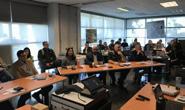
development opportunities, and a supportive community of industry peers.
Bay Cities’ participation as the host for this Road Show stop underscored the company’s leadership within the AICC community and its dedication to fostering a collaborative and innovative industry environment. The event served as a platform for learning and networking and demonstrated the tangible benefits of AICC membership, including access to cutting-edge resources, professional
The AICC Road Show’s stop at Bay Cities is part of a broader initiative to engage with members across the United States, ensuring companies of all sizes and scopes can leverage the full spectrum of AICC membership advantages. The positive feedback and enthusiastic participation at this event reflect the value that AICC provides to its members and the industry.
If your company is interested in being a stop on the AICC Road Show, a no-cost member benefit, contact AICC Director of Membership and Marketing Virginia Humphrey at vhumphrey@AICCbox.org or 703-535-1383.
In 2023, more than 88% of consumers recognized the word “sustainability,” but despite the high levels of awareness around the world, only 26% of those same consumers can name a sustainable product, according to The Hartman Group’s Sustainability Report of 2023. This massive awareness gap creates an opportunity for brands and boxmakers alike that are trying to position themselves as environmentally friendly.
One of the clearest meanings consumers associate with sustainability is the recyclability of a product. With the potential for fiber reuse of up to seven times, the corrugated box is the golden child for recycling. And while many consumers claim to recycle regularly, the residential fiber recovery rate in the U.S. is estimated at only 40%, with two out of three boxes ending up in a landfill.
Improving this rate is the impetus behind a new residential recycling initiative rolling out nationwide by the Paper and Packaging Board (P+PB) The Box to Nature program’s goal is to tap into consumers’ desire to do their part for the environment, with a reminder of the simple steps they should take to properly recycle their boxes.
Reaching consumers at the point of package with an impactful message is the perfect opportunity to increase the residential recapture of fiber well above its current rate. But two key pieces need
to be in play: an emotional appeal coupled with instructive messaging. Recent message testing research by The Recycling Partnership shows that consumers’ actual recycling behavior improves when they receive more emotional and empathetic messages about recycling. When compared with other recycling marks, Box to Nature is significantly more motivating in part due to its emotional message: “This box has up to seven lives. Our planet has one.”

The other key component is the use of clear and simple instructions that help mitigate consumers’ confusion. The directive to “Empty, Flatten, Recycle” does just that. Qualitative research found that the Box to Nature graphic is dramatically more impactful at getting consumers to recycle than other recycling reminder marks—with 74% agreeing it would motivate them the most. This research shows that the Box to Nature mark presents the right message at the right time to engage consumers and to improve residential recycling rates.
The program has hit its stride throughout the packaging sphere with over 30 participating large and small box manufacturers. In terms of brand adoption, we have several well-known brands interested and moving toward adding the mark to their boxes.
Join the movement to get more boxes back. Contact P+PB at box2nature@ paperandpackaging.org, or learn more at www.paperandpackaging.org

Sarah Meiburg is director of the Box to Nature program at P+PB.


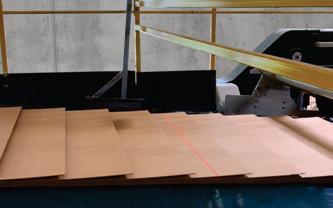

Monitor It — Identify It — Eliminate It
X Immediately identify and correct warp without operator intervention
X Continually measure 1200 points across the full web width with laser precision
X Produce high quality sheets sooner by utilizing Machine Learning algorithms (AI)
X Fully integrates and communicates with CoparSolutions’ QualityMaster™ System
Laser Warp Correction brings the latest AI technology to corrugator process control. This next generation of automation combines the precision of laser measurement with closed-loop process control to enhance sheet quality, improve consistency, eliminate operator error, and maximize productivity and profitability!





There’s a thoughtful, determined ethic in Brad Van Allen’s way of doing business: “We’re a good, family company. We’ve been around 70 years. We treat our people right, and we want to make sure our customers win.”
Van Allen is CEO of Northwest Paper Box (NWPB) in Camas, Washington, a small community across the Columbia River from the Portland, Oregon, metro area. The company was founded in Portland in 1953 by Marvin “Van” Van Allen and his wife, Betty, and William “Bud” Van Allen and his wife, Elsie. As Brad tells the story, his father and uncle worked at the time for Grigsby Paper Box, a setup box company. “My dad and my uncle and aunt all worked for Grigsby,” he recalls, “and at some point, the owner promised my dad and my uncle a bonus at the end of the year. He didn’t have any profits to give them a bonus, but my dad and my uncle
and aunt were counting on it. So, they said, ‘Maybe we can do it ourselves.’”
The seed thus planted, Van married, moved to Baltimore, and, while he was there, began buying up used setup box equipment. Meanwhile, back in Portland, his brother, Bud, got wind of the bankruptcy of another setup box company, Simpson Paper Box. The company and its assets were up for auction, and after rushing back to Portland with his truck filled with equipment, Van and Bud submitted a successful bid. “They found out how much the competition was offering,” Brad says. “So, they bid $1 more, and the next day, they started.”
The Van Allens named their company “Northwest Paper Box,” a tribute to their geography and their way of differentiating themselves from their competitors, Pacific Paper Box and Grigsby. It was also a sign to the market of the new company’s reach.
Company: Northwest Paper Box
Established: 1953
Joined AICC: 1996
Phone: 503-240-2800
Website: www.nwpaperbox.com
Headquarters: Camas, Washington
CEO: Brad Van Allen
The rich and diverse industrial base of the Pacific Northwest drove the company’s early growth. From its early location in Portland, NWPB served several industries, from food to metal stampings to commercial printing.
NWPB’s early success was founded in setup box specialty boxes and corrugated “triple-slide” boxes. Designed for heavier industrial parts, the triple-slide box consisted of three overlapping boxboard sleeves that essentially locked in the product. “Portland was a hub for Warn Industrial winches, and triple-slides were designed to carry heavy things,” he explains, adding that this style of box was common before die cutters became standard equipment in paperboard converting operations. “Most people have gone to die cuts now; the triple-slide was a really good package, but it was far more labor-intensive than a die cut.”
From the get-go, the new company was a family affair: Van, Betty, Bud, and Elsie ran the business, and when Van and Betty’s sons and their daughter, Debbie, were old enough, they worked, too. “All of the family worked there at different times, beginning when we were pretty young,” says Brad of his brothers Rod and John and sister, Debbie Guzie. “Sometimes my dad would bring home piecework for the whole family to do while watching TV— you know, jewelry boxes that get a piece of cotton in them or special inserts. He’d have this whole little setup for us.”
Brad and his brothers all came into the business at different times. Brad, the eldest, joined in 1981. After getting his engineering degree from Oregon State University, he went on to Indiana University for his MBA in finance. From there, he joined White Motors in Cleveland, Ohio, and Farmington Hills, Michigan. “I learned a lot during that time,” he says, adding, “I moved back because my dad started having health problems. I was 27 at the time.”
Rod, now a vice president, was the next brother to join the business in 1983. He received his industrial engineering degree from Oregon State University and spent two years working for Kraft Foods in Buena Park, California. “I was doing efficiency studies, layouts, and modifying work stations,” he says. “I joined Northwest Paper Box in 1983 after my father passed away.”
John, also now a vice president, is the youngest of the three brothers. He attended Santa Clara University in California, where he earned a business degree. He joined the company in 1987, after a brief career in the commodities business in San Francisco; now, his focus at Northwest Paper Box is sales and marketing. “Being the best looking of the brothers, it became apparent that they had faces for accounting and production, but not to be out amongst customers,” John recalls. “I was not thrilled with
the high-pressure sales arena of the commodities trade, and I was looking for a slower-paced living environment.”
In the late 1980s, the three brothers decided to expand their footprint beyond setup boxes. “At the time, the rigid box business was not a growth business,” John says. “We brothers wanted to continue to work together, and we chose corrugated as a logical expansion.”

It was not an auspicious beginning, according to Brad. “So, we opened up a plant to do corrugated and promptly lost our shirts. We had no idea what we were doing.”
The Van Allens began their bumpy ride into corrugated in a separate 20,000-square-foot building with a few pieces of rudimentary equipment: a 50" two-color printer slotter, a laminator, and a die cutter. Once the kinks were worked out, says Brad, things began looking up. “We thought we knew what we were doing at the start, but you know, there’s a learning process,” he concedes. “After we got our stuff together about how to price things, how to run things, we started making a little bit of money.”
That early profitability prompted the Van Allens to look for additional converting capacity in better equipment and, if the opportunity arose, to look for companies that may be interested in selling. Brad found both. “We found another company called Taylor-Made Packaging that did corrugated boxes,” he says. “They had a jumbo. We didn’t. They’d been in business a long time and were profitable, but the majority owner wanted to get out of the business.”
After the acquisition of Taylor-Made in 1993, the Van Allens consolidated their corrugated and their setup box businesses
in one location in the Swan Island Basin industrial area northeast of downtown Portland—a location they occupied until April 2023. It was during the 30 years at what Brad calls simply “the Basin” plant that the company continued to acquire equipment for both sides of their operations. “We were limping along with our printer-slotters and hand gluers, and we went to an AICC meeting and met Gene Wicks [former owner of Boxes Inc. in St. Louis]. He had bought a Langston Saturn III flexo folder-gluer, and he said, ‘We can run the hell out of this thing and swiftly change from one order to the next.’”
Brad credits NWPB’s membership in AICC for helping the brothers make prudent capital equipment investments. He recalls meeting Jim DeLine and Jim Davis of DeLine Box and Kevin Hartney of Peoples Capital at a meeting in Chicago. “My brother, John, and I went to the meeting, and those guys kind of double-teamed us,” Brad says. “We weren’t married then; we were just a couple of single guys trying to figure out what the hell’s going on. They took us in and made sure we got to meet everyone. Kevin Hartney was a great advisor who helped us make the decision to purchase a new Saturn flexo folder-gluer from Langston’s Ken Normann.”
NWPB’s growth from that point required additional investment in converting capacity in its corrugated and setup box divisions. Initially, says Brad, the choice was used. “We bought other used equipment,” he says, “but we felt like it was all going to be a problem going forward, so [we] started buying new.”
Rod looks after the equipment side of the business. “Rod is an engineer,” says Brad. “Anytime we do any kind of machinery or moving things around, he gets involved.”
The company’s machinery acquisition philosophy is multifaceted, as Rod explains. “There are a number of things we look at when considering capital expenditures,” he says. “First, we want to know if there will be gains in production efficiency, quality, and safety. Then we ask, ‘What sort of ROI can we expect?’ Or perhaps we can fill a niche where there is market demand and we could better serve that demand. Finally, we look at the availability of replacement parts and ongoing technical support via in-person visit or remote troubleshooting.”
With these criteria employed, NWPB has built up a respectable arsenal of converting firepower: On the corrugated sheet plant side, an Apstar 6-color rotary die cutter; a Langston Saturn III 3-color and an EDF Europe Encore 4-color flexo folder-gluer; a Bobst specialty folder-gluer; an Eterna die cutter; and a Universal 74" printer-slotter. On the setup box side of the business, NWPB has five Emmeci setup box machines, multiple Crathern & Smith HNS setup box-wrapper lines, and ancillary equipment such as shrink wrappers.
Growing the setup box business in a static market challenged the company to look for viable acquisition targets in the Pacific Northwest. Brad credits his AICC connections with the guidance they needed at the time for valuations and structuring the deals. “We had a really good banker we were working with, and
then we also had Mitch Klingher of Klingher Nadler LLP to talk to. We were talking about how to structure a deal, and over time, I learned some of these things,” he says. “Now, having bought four companies in the last 40 years, they have been important for our growth.”
The chronology of the acquisitions goes like this: In 1995, NWPB bought the setup box assets of Grigsby Paper Box. In 1998, NWPB acquired the setup box assets of Pacific Paper Box. Then, in 2016, NWPB acquired the assets of Universal Paper Box in Seattle, a move that opened up the larger Seattle-Tacoma market, where Brad says there’s “way more business.”
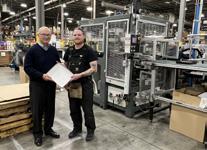
“With these acquisitions, we have basically consolidated the setup box business in the Northwest,” he adds.
The growth in volume eventually caught up with NWPB at its longtime location in the Basin industrial area in Portland. “Eventually, we felt like we had to do something to get more room to manage this volume,” Brad says. “At one time, we had 20 truckloads of material outside for most of the summer because we could not process it fast enough through our plant. We moved our hand-fed die cutters around the building 14 different times to squeeze things in there and add new equipment, but in the end, it just was not an efficient plant. This, combined with our expiring lease and an increasingly unfavorable business climate, property tax structure, and crime near our facility, made us decide to look around for other options.”
The search took them to Camas, Washington, to a former pressure washer company’s facility, where NWPB invested heavily in the 2023 move and site improvements, including environmental
upgrades to be a “good neighbor.” Brad explains, “We have spent over $10 million moving our equipment and upgrading our capabilities with our move to Camas from Portland. All of our upgrades were accomplished in order to drive out costs, increase efficiencies, and create growth opportunities. Our plant now is a showpiece of our customer-focused direction and capabilities.
“About $1 million was spent on a waste building, which houses our wastewater treatment and scrap baler,” he continues. “We designed the building to have the cyclone under roof because we wanted to significantly reduce the noise associated with scrap conveyance and be a good neighbor. Having it all in one place also creates a cleaner environment for printing and processing.”
The Van Allens also improved the work environment through new lighting. “We also spent roughly $200,000 on all-new lighting in the plant to provide a great working environment for our employees, create more accurate color measurement, and reduce energy consumption,” Brad says, adding that the result is a plant with “improved workflow, quality, and safety. These initiatives help us create great products, service, and pricing.”
NWPB’s solicitude for its employees has been a core value since the beginning. Brad continues his family’s desire to provide good careers for those in their employ.



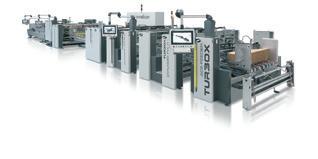 AUTOMATION
AUTOMATION
“Creating family living wage jobs” was one of four founding principles, he says.
The company lives this ethos today, even in a challenging labor pool such as Portland. NWPB currently has 97 employees and has found great success in finding people who, Brad says, “felt like there wasn’t a place for them in America anymore. The people that we have been able to hire and have success with might have had some past difficulties that made it hard for them to find employment. They are some of our better employees; they like it here. We’ve moved some of them up into greater roles of operators and supervisors.”
Recently joining the three Van Allen brothers is Steve McDonald, a 43-year veteran of the corrugated industry. His resumé includes longtime positions with Commencement Bay Corrugated, Western Kraft, and WestRock and its predecessors. McDonald’s role is that of a general manager, but his card has no title on it. “He gets into everything,” Brad says. “He helps John in sales; he helps the salespeople. He’s kind of my eyes and ears out there in the plant.”
He lauds McDonald’s talents in those areas important for a corrugated and setup box operation. “He’s really good with people and understanding what they want, and he does a really good job for us in purchasing, helping us get our material costs in line with where they need to be.”
The story of Northwest Paper Box is as much a family business success story as it is a story about success in the setup and corrugated box industry. Says Brad, “One of the craziest and most interesting stories about our business is the fact that we have three brothers working together—and have worked together— for 35 years. And there have been times we want to kill each other, sure, but each of us has our strengths.”
Not surprisingly, then, each of the Van Allen brothers has his unique view of the path forward for NWPB. “We anticipate
Civic and community pride is a recurring theme in conversations with independent boxmakers everywhere. Company lobbies are showcases for various Little League, United Way, and other community service commendations and certificates of appreciation. So, too, at NWPB.
The founding Van Allens’ location and investment in the City of Portland reflected their community-mindedness, which is evident in the company today. Even the company’s logo reflects its dedication to Portland—also known as the “City of Roses”—by the inclusion of a rose blossom in the letter “o” of Northwest. “My mother insisted on it,” Brad recalls.
In 1961, this civic loyalty was recognized when Marvin “Van” Van Allen was honored for his contributions to the city by being inducted into “The Royal Rosarians.” A few years later, William “Bud” Van Allen was also recognized. “At one of the various parades they attended, Betty, our mother, drove a float because the original driver came down with an illness,” Brad says.

The Royal Rosarians act by mayoral declaration as “the Official Greeters and Ambassadors of Goodwill for the City of Portland.” The Royal Rosarians were founded in 1912 as a public outreach philanthropy for the city, and membership is reserved for citizens of civic and philanthropic prominence.
The brothers have continued this family tradition of community service. They have been involved with church-related missions trips and church leadership; coaching sports teams; volunteering; and being on the board of a local charity, Sunshine Division.
creating cost-savings and competitiveness via robotics and systems improvements,” Brad says.
Rod agrees, emphasizing the workforce. “Finding skilled people or those with an aptitude for manufacturing is a challenge. We are always looking for the next ‘thing’ that will help relieve manual labor or methods to improve workflow.”
John’s perspective captures both, and he weaves into NWPB’s motto of “Integrity. Service. Quality.” Says John, “Overall, we believe there is an opportunity to stand
out with excellent quality and service. I honestly believe our reputation for being a stand-up company, with unquestioned integrity, has helped buyers and companies we deal with spread the word about NWPB in the marketplace.”

Steve Young is AICC’s ambassador-at-large. He can be reached at 202-297-0583 or syoung@AICCbox.org

superior graphics fast set-up
Max Speed: 12,000 s/h
Available Sizes: 2,800 (110”)
Max Sheet Width: 110.24 “
Max Sheet Length: 60.24”
Min/Max Caliper: .039/.354”
Features:
• 3 minute auto job change
• Setup while running
• Preset print and die cut
• Print and die cut inspection
• Anilox Roll Changing System (Full Automatic: 3+1)


inside-outside print fast set-up
Max Speed: 10,000 s/h
Available Sizes (max sheet):
2,100 / 82” (82 x 62.99”)
2,400 / 94” (94.5 x 62.99”)
2,800 / 110” (110.24 x 62.99”)
Features:
• 3 minute auto job change
• Setup while running
• Preset print
• Inside/Outside Print
• Print and die cut inspection
• Anilox Roll Changing System (Automatic: 2+1)
high-definition print fast ROI
Max Speed: 9,000 s/h
Available Sizes (max sheet):
2,100 / 82” (82 x 62.99”)
2,400 / 94” (94.5 x 62.99”)
2,800 / 110” (110.24 x 62.99”)
Features:
• Inside/Outside print
• Print and die cut inspection
• Anilox Roll Changing System (Automatic: 2+1)
For full features and specifications, visit koenig-bauer-celmacch.com Or contact Kevin Erbe at kevin.erbe@koenig-bauer.com, 303.718.0023


In a world where packaging is the consumer’s first see but, often, the brand owner’s last spend, boxmakers are stepping up their marketing games, using the power of digital communication strategies to promote the power of corrugated.
Consider the example of the “Thanks, Domino” videos from Domino, which harness diverse and unique industry voices. Any respectable video can help recharge branding and engagement, but a video made with high production values and industry players up and down the supply chain touches the hearts and minds of viewers.
Independent II was Domino’s first corrugated digital printing press client in North America and is now a partner in the familiar “Thanks, Domino” series. “It’s a little bit of a lightning bolt, and a greeting,” says Finn MacDonald, president of Independent II. “It’s a visual invitation to excite the viewer about who we are.”
In 2012, Bill Myers joined Domino, based in Gurnee, Illinois, as marketing manager for digital printing solutions. He was charged with raising the visibility of Domino’s brand. Label converters were his target audience then. As he got to know them, he noticed their willingness to share information among themselves, “even when they competed against each other.”
That led to Myers’ “lightbulb moment,” when he realized that raising awareness of Domino didn’t mean talking up its machine specs but capturing the voices of customers addressing the advantages gained through Domino’s solutions. “If these individuals know each other, trust each other, and have credibility with each other, why not have them tell their
story?” he says. “Let’s give them the spotlight and let them tell their story, and as a byproduct, they’re helping tell the Domino story.”
That was the beginning of the “Thanks, Domino” videos. Small and medium customers lacking in-house marketing were especially receptive. Myers offered to be “an extension of their company,” heightening their visibility through news releases, public relations, case studies, and professionally produced videos. It would all be financed through Domino’s marketing budget.
The customers involved tell him they expected the highly professional aspect of the experience but were surprised by the fun they had. “We view our customers as our business partners,” says Myers. “And
we enjoy providing this value-added marketing for them. These videos are not something they soon forget.”
When Domino entered the corrugated arena, the same approach still made sense. The videos help position Domino digital printing as an industry thought leader while they also build trust.
When Independent II installed the Domino X630i digital aqueous inkjet corrugated press, MacDonald immediately grasped the significance of the videos. The meticulous process of filming, writing, and producing forces a deep dive into the key questions justifying any company’s existence, he says. Who are you? What do you do? Why do you love what you do? What makes you stand out?

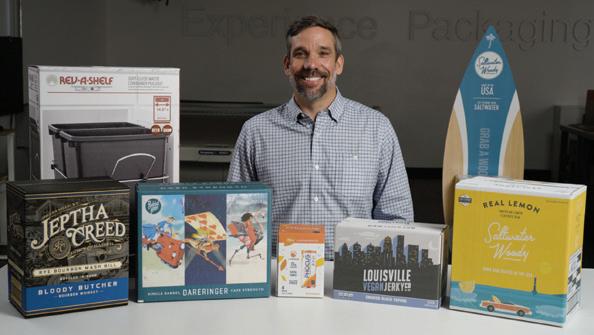
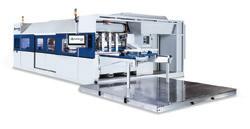



S S LLE I N S YS E N HE ARKE
Engineered Recycling Systems takes decades of engineering experience and system integration expertise to provide our partners turnkey solutions.
We engineer, design and install world-class scrap collection and dust extraction systems providing our customers with equipment and system designs that deliver unprecedented levels of quality and craftsmanship, our solutions increase production and cut labor costs.
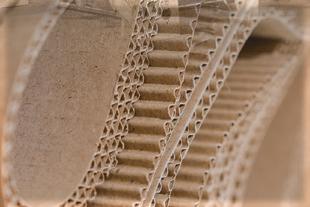
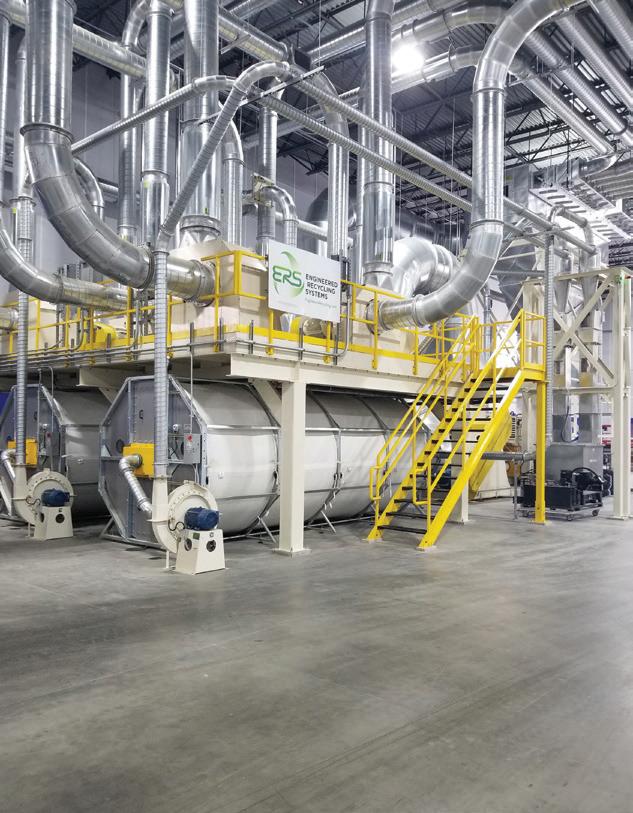
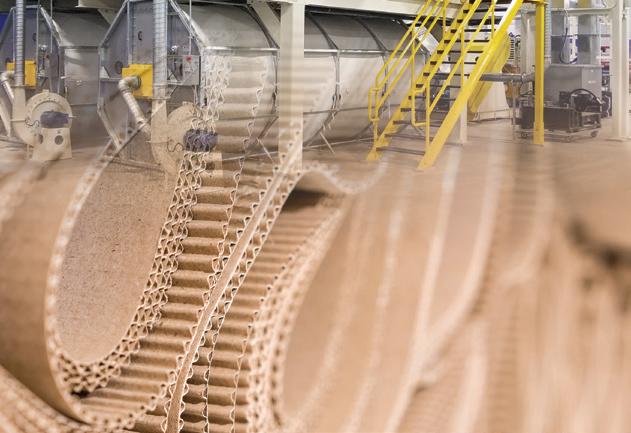
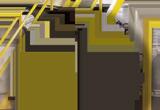


• No compressed air, water, explosion vents or high-speed abort gates required
• No ladder or lifting equipment needed for servicing
• System operates without housing, ensuring it is not considered a confined space
• Lower maintenance costs
• Less production downtime
• Minimal time required for changing out filter media
• No makeup air required
• CCM® OCT Filters = SAFE to operate and maintain
“The videos really force you to answer those questions quickly, with some enthusiasm,” he says. “The whole goal is engagement, even among your own people, in the way that you see yourself and want to be seen.”
With Domino’s experience in making voice of the customer videos, asking Independent II for a testimonial was self-evident. MacDonald had been a Domino advocate, and he was—and is—open to letting any converter see the press at work.
As they were shooting video, MacDonald wondered if some of his own customers could be featured. That idea brought “the voice of the customer’s customer” into play. From the Independent II perspective, the videos tell stories of productivity, efficiency, and speed in manufacturing, made possible by the Domino press.
Then comes another layer. Brand owners share how digital printing transformed the plain corrugated of the past into a package projecting stories of recycling, company history, and customer interactions.
MacDonald remembers when he was assigned to rebranding Independent II without touching the third rails of highlighting customers, showing finished products or the plant floor, or divulging any corporate secrets. But as he puts it, companies worried that a video would empower competitors to pilfer their customers that “have more problems than just marketing.”
“I was pretty comfortable early on saying that if we have great relationships and we are doing a good job and our customers will speak to this, then why don’t we post it?” he says. “Why don’t we make use of what’s good and let others see that?”
As new technologies such as digital printing revolutionize the boxmaking

“If we have great relationships and we are doing a good job and our customers will speak to this , then why don’t we post it? Why don’t we make use of what’s good and let others see that?”
—Finn MacDonald, president, Independent II
industry, parallel innovations in communications are vital to spreading the word up and down the supply chain, MacDonald says. “If you go to a customer and ask them to block out a day to discuss what they’ve experienced through our solutions, they’re enthusiastic about it. They’re kind of shareholders in the digital printing technology. It’s helped them get further faster than they thought they would. I think they really feel like if it helps us, it helps them,” he says.
Some businesses, understandably, remain reluctant to reveal their secrets,
says Myers. Those who agree to the videos have been impressed with the professionalism of the process and in the results.
“The ones that say yes seem to be the ones that want to take their companies to the next level,” he says.
Myers preps the video participants on what to expect from a full day of shooting video, including stand-up interviews and b-roll background shots of the facility and machinery in action. The company chooses the interviewees. Myers likes a versatile selection of spokespeople from the C-suite, sales, operations, and
production, giving every viewer someone to relate to.
The Domino videos even have a tagline so recognizable that people sometimes approach Myers at industry events and say, “Thanks, Domino.” The line originated with a customer who said it during filming, and Myers realized he had a hook for future videos.
The latest Domino-Independent II collaboration, released early this spring, demonstrates the following principles the partners deploy for effective videos:
• Voice of the customer: As MacDonald talks about Independent II ’s “incredible changes,” they are made visual. Exterior drone shots show the 340,000-square-foot facility. Interior drone shots—yes, interior—illustrate MacDonald’s news that productivity has skyrocketed since construction of the state-ofthe-art facility and installation of the Domino press.
• Voice of the customer’s customer: Officials from three highly reputable but contrasting businesses address the difference that digital printing has made. Rev-A-Shelf found that digital printing changed the way it does business and services customers. Rabbit Hole Distillery can efficiently modify its ship cases in real time. Small Pet Select can make changes on the fly. “It has really elevated our business to the next level,” says Small Pet Select Product Buyer Josh Price.
• Varied voices: Independent II team members deliver the message from their perspectives. The digital manager hails the instant gratification of digital printing and calls the demo process “easy peasy.” The senior sales partner addresses speed to market, and the director of business process notes the simplicity of processing
“It’s taking what we love as humans, which is very visual, and bringing it to life. They say a picture is worth a thousand words. I feel like a video is worth a million. It really takes it to the next level.”
—Bill Myers, marketing manager for digital printing solutions, Domino
customer orders. A digital operator lauds the high-definition printing and easy-control colors. All are smiling, spontaneous, and comfortable in front of the lens.
• Animation: It’s a whole new ballgame in visualizing the power of digital printing. There’s a voiceover of Small Pet Select’s Price, discussing the power to seamlessly enhance packaging with colors, stories, and breaking news. At the same time, viewers watch the transformation of a Small Pet Select box. It starts as its old tricolor before flipping to a multicolor box, still printed in Small Pet Select’s signature green but deftly touched with blue, black, and gold. The box continues flipping to show the company’s story of family ownership on one panel and a Newsweek “America’s Best Petcare Brands” badge zooming in on another.
• A consistent message: The video ends with all five Independent II interviewees saying, “Thanks, Domino.”
Slick videos and podcasts can make a splash when unveiled at conferences, but the return on investment demands strategies to attract viewers and compel them to action. Myers posts the videos on YouTube, and he drives audiences there with news releases and ad placements in industry media, LinkedIn posts, showings at events and
in the Domino trade show booth, and industry e-newsletters. They are easy to find on Domino Digital Printing North America’s YouTube channel, youtube. com/user/DominoDigitalPrint , and website, dominodigitalprinting.com
He also prepares a version for the featured customers, capped with their contact info, including logo, web address, and phone number. In turn, they apply their own distribution strategies, sharing the videos through websites, distribution channels, and industry events. Posting on company websites creates a succinct, visual tool for sales teams to use.
“It’s almost like we’re providing this window for other companies to see into their company,” Myers says. “It’s taking what we love as humans, which is very visual, and bringing it to life. They say a picture is worth a thousand words. I feel like a video is worth a million. It really takes it to the next level.”
The videos are in-house morale boosters, adds MacDonald. Team members accustomed to watching YouTube videos see their work and their colleagues featured there, and they are “proud to see a product like this in a platform they watch all the time.”
In a high-tech age, production quality matters. Morning Time Productions has collaborated with Domino since the dawn of the videos, operating as “truly a business partner,” says Myers. The process is hands-on, with multiple revisions
until the message and look are honed for impact and promise lasting relevance.
Morning Time’s knowledge of the industry provides context for the videos, allowing the subjects interviewed “to feel comfortable and expand on what they want to say,” says MacDonald. A dynamic conversation helps them “get to the point faster,” and a filming process that the customer might have dreaded as tedious becomes fun and productive.
“I can’t tell you how natural it’s been,” MacDonald says.
Seizing the power of digital communications reminds Myers of a favorite quote. “I’ve learned that people will forget what you said, people will forget what you did, but people will never forget how you made them feel,” said the great poet Maya Angelou. Connecting with people
in a way that touches the heart, beyond demonstrating what a press can do, is “the most powerful form of marketing.”
“That’s why I love utilizing voice of the customer,” he says. “It’s one person on camera who’s sharing their story. You can relate with them. How did this make me feel? What did I learn from that?”
MacDonald advises that any boxmaker purchasing a new machine should discuss the mutual benefits with the manufacturer. Use the time to talk about marketing tools and strategies. Capture content such as videos along the journey, “so when it’s done, you have narrative and talking points. If you seek to increase your brand awareness, that is a very efficient way to do it.”
He also advises tuning in to AICC’s website and AICC Now (NOW.AICCbox. org ) for its growing portfolio of resources where members share information and
find inspiration. As younger people who grew up talking and sharing in front of cameras enter the industry, the time is here to continue putting resources into 21st century communications tools that “educate and inspire and inform.”
“We love what we do,” MacDonald says. “We love to talk about it. As we move forward, we will continue to push our brand and story out using a combination of print and video and podcasts that everyone can access and enjoy. I think our best years are coming, and these digital platforms allow us to grow our business, our brand, and our connection to the marketplace.”

M. Diane McCormick is a freelance journalist based in Pennsylvania.
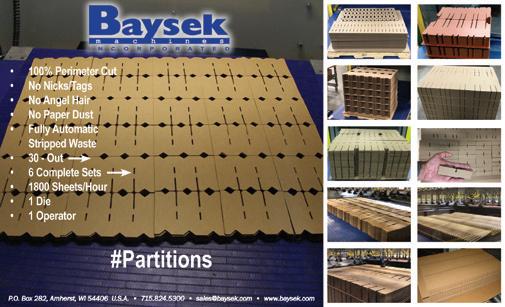

High quality, speed, efficiency, and long life are helping flexographic printing remain a top choice for today’s boxmakers
By Robert Bittner
Flexographic printing has played an important role for corrugated converters since the 1940s and the introduction of the first mechanically engraved metering roll, known as an anilox. Since then, advances in ink technology, anilox development, and ever-improving machinery have secured flexo’s place on shop floors around the world.
Although the rise of digital printing over the past two decades triggered concerns regarding flexo’s future, flexo remains the gold standard of printing within the industry.
The common metaphor for describing how flexographic printing works is to imagine a rubber stamp operating on a continuous loop. “You’re transferring a known quantity of ink to a plate, and that plate is transferring ink to some kind of substrate—and you’re doing this in the round,” says John Burgess, president of Pamarco.
“The quality of the printing is determined by the amount of ink you’re transferring to the plate and from the plate to the substrate,” he continues. “The thickness of the ink film being transferred dictates the quality, the fidelity, and the aesthetic look of the print.”
Achieving flexo’s high quality requires that several elements all have to work together. “The plates, the inks, and the machinery are all critical,” John says. “There isn’t just one component that dictates a good box.”
John and his twin brother, Dave Burgess, have been involved in one way or another with printing for most of their lives.
It began with their father, Alan Burgess, who worked for many years as the managing director of United Kingdom-based Cunliffe Whitham Holdings. He was primarily responsible for the engraving of gravure printing cylinders and steel embossing rolls—progenitors of today’s anilox rolls—for the decorative wallcoverings industry. In 1979, he accepted a position as executive vice president of sales for Pamarco Inc., and the family moved to the United States. “John and I both worked for Pamarco for many years,” Dave recalls. “I was vice president of sales, and he was vice president of manufacturing.”
Dave left Pamarco about 15 years ago. Today, he is sales director for JB Machinery, a supplier of products designed to enhance productivity and overall quality for die cutters and flexo machines.
Both brothers have built their careers serving the corrugated market with flexo-related products and services. In their
experience, it is an industry that continues to embrace flexo’s benefits—and it’s not the only one.
In The Future of Flexographic Printing to 2025, a 2020 market report by David Zwang of Smithers, the global value of flexographic printing was predicted to rise from $168 billion in 2020 to $181 billion by 2025. Zwang’s research indicated that sales of new flexo presses would increase by 0.4% each year to 2025, complemented by what the report called “a thriving secondhand and press enhancement/ refurbishment sector.”
Granted, these are relatively small increases. But they highlight the fact that flexographic printing continues to be a competitive choice even in today’s marketplace. There are several reasons why.
Speed. Modern flexo presses are capable of printing at up to 600 feet per minute. “On a flexo folder-gluer, a top printer, we’re seeing people hitting speeds of 20,000–25,000 boxes an hour,” Dave says.
Efficiency. Every flexo print run requires time and money to create printing plates, a step that might be considered a downside to flexo printing. Yet once those plates are made, they can be used many times over without additional expense. This means that larger print runs will have lower per-unit costs. And it results in lower overhead and less prepress time when running repeat orders in the future.
Efficiencies do not stop there. Many modern flexo presses include in-line converting capacity as well as other functions such as foil work, lamination,
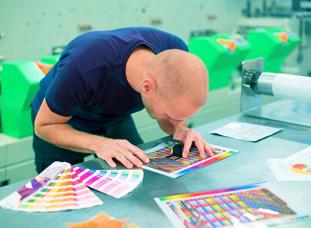
“There are a lot of flexos that have been running 20, 30, 40 years in the field. Old flexos never die; they just go somewhere else to play.”
—John Burgess, president, Pamarco
multilayer and reverse-side printing, and radio frequency identification insertion. Adhesives, coatings, and varnishes can also be applied in-line, streamlining the production process.
Durability. “These machines are built to last,” John notes. “There are a lot of flexos that have been running 20, 30, 40 years in the field. Old flexos never die; they just go somewhere else to play.”
“Once they’ve outlived their usefulness in the United States, they often take on a whole new life in other countries,” Dave adds. “Unlike older digital machines, older [flexo] presses were built like tanks. They are still working and may run for years and years. They’ve got fantastic side frames, and most of them are old-fashioned gear machines,” which may make them easier to maintain and repair than more modern, servo-driven machines that rely upon computer control.
The introduction of computer-controlled servo drives for flexo printers is just one example of how ongoing innovations are ensuring flexo’s relevance today.
“Look at the money that the larger equipment builders are putting into the flexo side of the business,” Dave notes.
“At one time, they supplied the printer and die cut portion but let other companies produce the feeder, the stacker, the material-handling side of the process. Now they are investing big-time in machines that do it all, providing a true one-pass solution.”
That original equipment manufacturer commitment is leading to equipment that continues to get faster, more efficient, and easier to use, while delivering ever-improving levels of quality. “We now have the ability to print much higher line screens—using 800- and 1,000-line aniloxes, compared with a standard machine that uses a 250-line anilox— which allow us to put down much thinner ink films,” John says.
“Digital has its place, and it satisfies a particular niche market. But flexo remains the high-quality printing choice for long runs.”
—Dave Burgess, sales director, JB Machinery
In addition, new accessories have improved customers’ ability to switch out different aniloxes, altering the types of graphics being printed. It is an advancement John describes as “massive.”
“Some people are working with turrets for their anilox rolls, allowing them to store two, three, or four anilox rolls in each print station,” John says. “With the press of a button, you can change the anilox. So, rather than taking a big lump of metal out—these aniloxes each weigh 1,500 pounds or so—and then exchanging it for another one, you can flip a switch and move from one anilox specification to another. That means you could go from a very high-graphics job for point-of-purchase sale displays to a very low-end e-commerce box just by flipping a switch. When I first got into this industry, there were some cases where it would have taken us 12 hours to change an anilox. Now it’s down to minutes.
“The latest innovation is the ability to print inside and outside the box. In days of yore, you’d have to double bump the sheet to print both sides. Now a lot of machines can top print and bottom print on the same machine, which is often apropos for e-commerce, where you can print some nice graphics inside the box.”
Not every innovation is just about putting ink on substrate, however. “We’ve been working diligently on trying to produce products that reduce the role of the operator in the process,” Dave reports. “Because the reality is that every time we go into plants, we’re seeing a different operator. The labor market’s been challenging the last few years for boxmakers, so we want to do whatever we can to make the equipment easier to use and maintain regardless of how a plant may be staffed.”
Once digital printing became a viable option for boxmakers, a popular topic for conversation was how digital printers would eventually replace mechanical presses, much as email has largely replaced traditional letters. It seemed like a reasonable possibility.
“In the old days, flexo’s printed graphics didn’t come out as well,” John recalls. “I think that helped digital get its jump in the market, to some extent.” But times have changed. “Today, flexo has a very good name.”
Yet the “either-or” discussion around digital versus flexo continues. Both Burgess brothers think there is a better way. “Some continue to look at flexo and digital as competing technologies rather than complementary ones,” John says. “My business is equity-owned. And my equity owners read all the financial papers and trades and say, ‘Digital’s going to take your business away in 10 years. What are we going to do?’ My response is that I think digital is a very complementary product to flexo. The ideal to me is a shop that has both digital and analog equipment—analog being flexo—and does the short-run stuff on digital and the long-run stuff on flexo. And there are a lot of shops like that out there now.
“The problem with the idea that digital is a replacement for analog printing, like flexo, is that the speed of technological change means that the digital printer you buy today could be obsolete in two years. Then what the hell are you going to do with that machine? Nobody wants an out-of-date digital machine.”
“Digital has its place,” Dave adds, “and it satisfies a particular niche market. But flexo remains the high-quality printing
choice for long runs. If you look at some of the new machines, they are very accurate, high-productivity machines. And let’s not forget the value of making a box and then printing a very simple image on it; that is not something that’s going to be done with digital. The whole point of digital is to put a lot of colors on a sheet, to give yourself some brand presence. You’re not going to waste the money it costs to produce digitally on a simple brand box.
“Most of our customers in North America want a single-pass solution, where they can print, die cut, fold, and glue all in one run. It’s never been really popular to print and then take it offline—which is what you have to do with digital—and then come back and finish it, die cut it, or whatever you’re going to do to it. We’re not Luddites, though. I’m not going to say that digital will never come to replace other machines. But I believe its rate of growth is way slower than the digital machine manufacturers were hoping.”
Having said that, Dave is convinced that digital has a unique advantage over flexo when it comes to the future of the industry. “Digital printing is bringing younger people into our industry because of the front-end digital requirements,” he says. “It’s great to see some youth and talent coming into the business. And even though they’re coming in on the digital side, who knows where they’ll end up?”

Robert Bittner is a Michigan-based freelance journalist and a frequent BoxScore contributor.
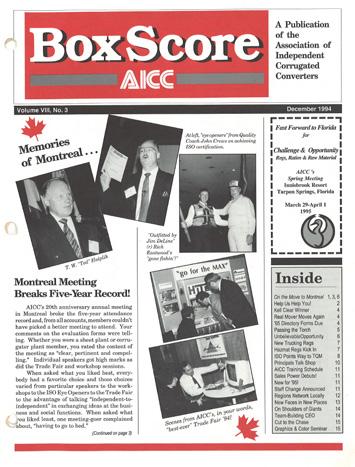
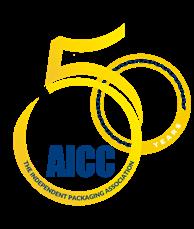
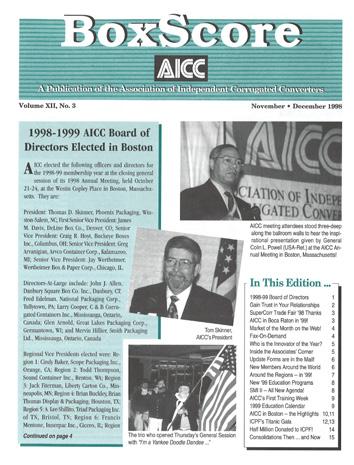
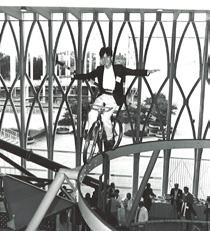
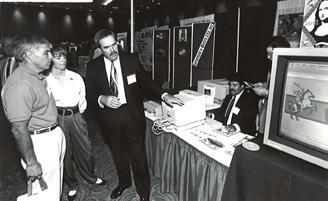

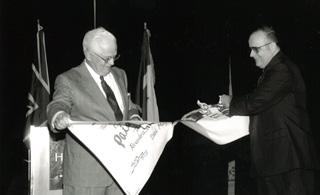
The mid-1990s marked a significant evolution for AICC as it broadened its scope of services and educational programs. In 1995, in collaboration with M.S. Ackerman & Co. LLC, AICC introduced the School for Financial Managers & Controllers, underscoring its dedication to equipping senior-level personnel in independent box plants with essential skills. This initiative was followed by the inaugural AICC Sales Management Institute in 1996 and the Production Managers’ Forum in 1997, tailored to meet the evolving needs of industry professionals.
A pivotal moment came in 1996 when AICC initiated a comprehensive long-range planning session involving key stakeholders. Spearheaded by AICC’s 23rd board chair Joseph R. Palmeri of Jamestown Container Cos., this endeavor aimed to chart the Association’s future course, aligning its resources and programs with the emerging trends and challenges faced by the independent sector.
As demographic shifts reshaped AICC’s membership landscape, a new generation of leaders emerged. To facilitate this transition and preserve the Association’s vitality, the Next Generation Committee was established, providing a platform for young members to contribute and thrive within the organization. This committee eventually succeeded itself out of existence as the generation it nurtured took the reins of their companies. The Next Generation Committee was one of the
precursors to AICC’s current Emerging Leader program.
Recognizing the value of collaboration, AICC embarked on strategic partnerships to enhance member services. Under Palmeri’s leadership, AICC joined forces with TAPPI in May 1997 to co-sponsor SuperCorrExpo 2000, North America’s premier corrugated machinery show. This groundbreaking collaboration underscored AICC’s commitment to driving industry innovation and excellence.
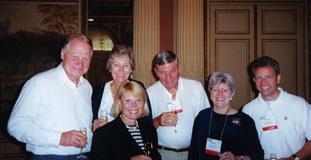
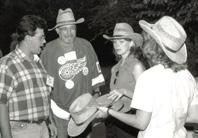
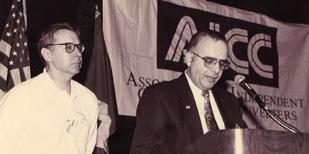
James E. Haglund, 1994–1995 Central Container Corp.
William I. Flinn, 1995–1996** Scope Packaging Inc.
Joseph R. Palmeri, 1996–1997 Jamestown Container Cos.
Richard Kelley, 1997–1998** Dusobox
Thomas D. Skinner, 1998–1999 Phoenix Packaging Inc.
James M. Davis, 1999–2000 DeLine Box Co.
Craig R. Hoyt, 2000–2001 Buckeye Boxes
Greg Arvanigian, 2001–2002* Arvco Container Corp.
Jay Wertheimer, 2002–2003** Wertheimer Box
* AICC changed the name of its chief elected officer to “chairman” in 2001; at the same time, the chief staff officer’s title became “president.”
**Of happy memory
In 1998, AICC formalized its cooperative efforts through the FirstPak program, aimed at expanding members’ capabilities and market reach. By petitioning regulatory bodies such as the U.S. Department of Justice and the Canadian Competition Bureau, AICC paved the way for joint-selling entities among members, enabling them to better serve national and regional customers while adhering to antitrust regulations. This program continues to provide value to members today.
Throughout this transformative period, AICC remained dedicated to fostering international partnerships and outreach. Initiatives such as engaging with Latin American boxmakers underscored the Association’s commitment to global collaboration and knowledge exchange. The dawn of the new millennium heralded continued growth and innovation for AICC. The signing of a 20-year agreement with TAPPI in 2001 to cosponsor
SuperCorrExpo affirmed AICC’s enduring commitment to industryleading events and collaboration.
AICC’s global engagement expanded further in 2002 with its participation in international industry meetings and the establishment of AICC México, reflecting the Association’s commitment to fostering excellence and innovation beyond North American borders.
In response to the challenges facing North American manufacturing, AICC, under the leadership of then-President Jay Wertheimer of Wertheimer Box, launched the “Make it in America” campaign in 2003. This initiative, underscored by trademarking the campaign logo and annual Washington Fly-ins, aimed to advocate policies supporting a robust manufacturing base, reinforcing AICC’s role as a champion of industry advocacy and innovation.
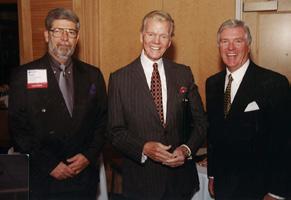

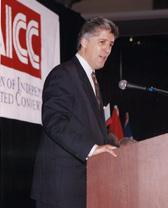
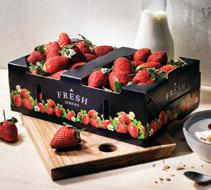
Our future depends on respecting nature. That is why we source our raw material from sustainably managed northern forests and together with its partners, Metsä plants over 30 million trees every year to ensure that forests grow more than they are used. All the way from the forest to the consumers and with easy recyclability, Metsä Board’s premium products are the natural choice for sustainable packaging.
Together we make the perfect package
metsagroup.com/metsaboard/

JOHN BURGESS PAMARCO VICE CHAIRMAN JOHN.BURGESS@PAMARCO.COM

TIM CONNELL A.G. STACKER INC. CHAIRMAN TCONNELL@AGSTACKER.COM

JEFF DIETZ KOLBUS AMERICA INC. SECRETARY JEFFREY.DIETZ@KOLBUS.COM

MIKE BUTLER DOMTAR PACKAGING DIRECTOR MIKE.BUTLER@DOMTAR.COM

GREG JONES
SUN AUTOMATION GROUP
IMMEDIATE PAST CHAIRMAN GREG.JONES@SUNAUTOMATION.COM
With the AICC Spring Meeting in the rearview mirror, the attention of many Associate members now turns to two important upcoming events, DRUPA and SuperCorrExpo. Unless you have been in the middle of one of these large shows, I am not sure anyone knows or quite understands the challenge of putting together a plan that is going to attract customers to the booth and create that much sought-after return on investment.
DRUPA is the biggest single print show in the world, occurring every four years in the fairgrounds in D ü sseldorf, Germany, and running for 10 consecutive days. While in the strictest sense of the word, this isn’t only a “corrugated” show, many familiar names will be exhibiting and displaying their products for all markets—corrugated, tag and label, but primarily flexible packaging. Digital print has become a much larger part of the show in the past few years, with now almost one entire exhibit hall dedicated to the medium.
The show’s biggest challenge is finding accommodations for your staff within hours’ drive of the fairgrounds and then rotating staff in and out to cover the 10 days of the show while trying to run your business in the usual manner. This is the first post-COVID-19 DRUPA; it has been eight years since the last iteration. Then, the average visitor count was 350,000–400,000 people from every corner of the world.
Next is SuperCorrExpo in the fall in Orlando, Florida. This has become a popular show for the independent and integrated sectors of our market where they see new technologies and hopefully add much of what they see into their
next capital budgets. SuperCorrExpo is different from many trade shows in that it is a mix of technical sessions and exhibition time, so for the exhibitors, it is not quite as taxing as a DRUPA but requires a huge amount of planning and execution.
The length and breadth of the corrugated industry will be on display at SuperCorrExpo, from converting and corrugating machinery to essential suppliers such as ink and printing plate vendors. This is a great opportunity to see all of your suppliers in one place; even if you are not in the market for new equipment, this event can start to give you ideas for the future.
DRUPA and SuperCorrExpo are essential ways for us, as Associates, to meet many of our good customers outside of the hustle and bustle of the plant environment and hopefully meet potential new customers, as well as co-suppliers, to plot our course through the market for the next several years. It is not inexpensive to attend and exhibit at these shows, so if you are attending, we ask that you try to visit most booths. Equally important, when the Associate member follows up with you after the show, allow them the opportunity to spend some time with you or your colleagues in your facility to get a real understanding of your needs and challenges. Many of us are quick to hire consultants to look into our businesses and forget that there are hundreds of years of experience within the Associates group that can be readily available.
John Burgess is president of Pamarco’s flexo division and vice chairman of AICC’s Associate board.



Acustom print solutions company based in Hamilton, Ontario, was seeking the best solution for printing directly onto corrugated board to offer the most up-to-date and efficient solutions to its customers. With a team of designers, innovators, and print and color experts, the Canadian company wanted a solution that would significantly enhance its end-to-end offerings and expand the application possibilities of corrugated print.
According to its president, the company selected a single-pass digital printer to meet these needs. “We chose [digital printing technology] because of the intense color and gloss levels that our customers were looking for,” he explains. Digital print technology’s accurate imaging capabilities help ensure color consistency for the many brands the company serves so the team can achieve specific Pantones and adhere to brands’ specific color palettes. It enables the company to print directly onto boards at high speeds and with superior quality and productivity. Digital printing technology eliminates the need for printing plates, delivering cost savings as well as reducing waste, and it avoids minimum order quantities (MOQs), making it
more accessible and faster than traditional analog litho production methods.
The company prints only what each customer needs, at a competitive price, eliminating inventory waste that can occur when MOQs are in place. Digital printing significantly improves the company’s time to market, critical to its customers and in today’s competitive marketplace. “It’s not only a cost discussion but also speed to market,” says the company’s chief operating officer (COO). “We can immediately send a file to our [press] and start printing rather than waiting for a new die or even changes in dies.”
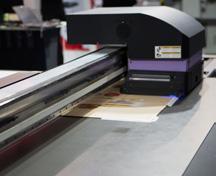
“[It] really enables us to really respond to current market trends for our customers,” says the COO. “Also, to create alternative designs for something like regional campaigns or activations. So, it gives some great flexibility for our customers and the ability to enable them to be successful.”
The company can also offer variable data printing, allowing for more personalization and customization—for example, printing the name of an individual recipient on every box. The digital technology also enables the company to produce versioned designs for regional brand activations, seasonal campaigns, sales events for different stores, and more.
Digital Printing on Corrugated Packaging and Its Impact on Carbon Emissions Thursday, June 13, 2024 | 2:00 p.m. ET
AICC is hosting this webinar that was created with the support of EFI.
For more information and to register, visit www.AICCbox.org/events/EventDetails. aspx?id=1839678&group=
The president adds, “There is significant value in the sheet size we can print. The print width allows us to print club packs and displays. And the gloss level has really competed with the litho space. We’re able to change over a lot of our litho customers.”
Digital printing also uses less water and energy than flexo or litho, the COO explains, and less overall waste. “So, from an environmental perspective, it helps us help our customers to reach their sustainability goals,” he says.

Chris Burdick is sales director of packaging at EFI.




































As discussed in part one (“Getting Back to Basics,” BoxScore, November/December 2023), material margin and time as expressed in machine hours are the keys to predicting profitability for most converters (throughput and velocity). But there is so much more to it than that, and each operation is slightly different. So there is no real cookie-cutter approach to reporting.
A large corrugator operation that is converting in excess of 100,000 msf, or 1,000 square feet, per month is going to look at things a lot differently than a small specialty sheet plant that is trying to sell value-added and niche products. There is, however, a tremendous amount of commonality even between these two diverse operations such as:
• A large investment in equipment.
• A plant workforce consisting of direct labor, indirect labor, and shipping labor.
• An inventory of raw materials, work in progress, finished goods, spare parts, and shop supplies.
• A maintenance department.
• A customer service department.
• A design department.
• An accounting department.
• A cost-estimating system and employees who utilize it.
• A salesforce.
• Various other administrative and management personnel.
In some of the larger operations, there is also a purchasing department, a marketing department, an estimating department, and probably a few others. Some converters who are doing high graphics and point-of-purchase or
point-of-sale packaging will have a large number of project coordinators and much larger design departments. The point of all of this is that most financial statements I see are simply listings of expenses broken up into two or three large categories such as factory overhead, shipping and delivery, selling, and general and administrative expenses. The lead page of your statements needs to be neat, concise, and on the expense side categorized by functional cost centers. Broad categorizations such as selling expenses or general and administrative expenses don’t tell you much about your operation.
Having categories like design department expenses, customer service department expenses, or maintenance department expenses gives you the ability to look at real departmental costs of your business and to give each manager the ability to budget and track their departmental costs, without showing them the entire financial statement.
In the first article in the November/ December 2023 issue of BoxScore, I talked about the need to separate manufactured from nonmanufactured sales, and that is a great first step at improving your reporting. The key question is whether there are definable profit centers within these two broad categories. For instance, your nonmanufactured activities may include assembly and fulfillment, sales of packaging supplies, sales of brokered corrugated, wood products, foam products, brokered folding cartons or setup boxes, etc. You need to have a system of tracking the profitability of each of these items. Lumping them into the “nonmanufactured”
bucket is expedient but not particularly informative. Similarly, you manufacture different kinds of boxes and price them very differently. Your sales of boxes coming off your flexos may be priced differently from boxes coming off your die cutters. Boxes that go through two or three machine centers are likely priced differently than boxes that go through one machine center. Boxes that include high-graphic content, whether it be direct print flexography, laminated lithography, digital, or some kind of preprint, are also going to be priced differently. You need to have a system of tracking this as well.
Many of you tell me the reason you cannot do much of this profit center reporting has to do with software limitations, and I agree that the prevalent software companies don’t provide a lot of room for sales analysis. However, all of the systems allow for a flag called product codes, and these product codes can and should be customized to help you create profit centers. If you set up your profit codes to track profit centers, the system will give you a pretty good idea of the gross sales side of the equation. Most systems I see in my travels have the product codes set up to be box styles. I advocate setting them up as profit centers. A combination of machine routings along with various graphic codes and various categories of nonmanufactured sales will give you a lot more information on the sales side of your business.
The cost side of this equation can be mostly handled within your general ledger. For each profit center, there must be a corresponding general ledger account that records the

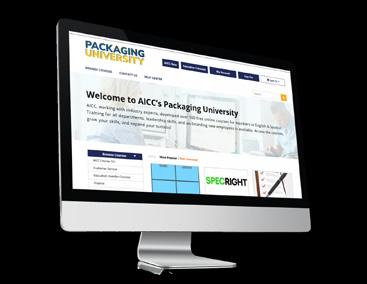

materials purchased specifically for that category of sales. Simply having one account for purchased products is not conducive to this type of reporting, but it does make life easy for your accounts payable department. The same can be said for the purchase of sheets, labels, and preprint. Multiple accounts for these types of purchases must be set up and maintained. Digital sheets, white top sheets, triple wall, and other nontraditional sheet purchases must be segregated into separate accounts.
If you go back to the first article in this series, material margin is the king of the converter’s financial statements, and if you can get the material margin correct for each profit center, then you can get a pretty good sense of where you are and aren’t making money. Most software systems are geared to track
contribution rather than material margin, which is likely to include direct labor, freight, and variable factory overhead. Although these expenses are real, it is quite difficult to allocate them back to the order with any precision, which is why I recommend using material margin alone. If you can then marry the machine hours and the labor hours for assembly and fulfillment to material margin, you can really focus in on the various categories of profitability. I have seen that this kind of analysis, while not always pristine, can help you effectuate meaningful change in your business.
Orders you thought were extremely profitable may not look as good through this lens, and conversely, orders you thought were extremely unprofitable may start to look a lot better to you. The bottom line is this:
1. Do not let limitations in your software packages deter you from taking a closer look at the components of profitability in your business.
2. A focus on material margins and time will help lead you in the right direction.
3. Creating and maintaining cost centers based upon the significant functional departments in your business will give you a lot more information about your cost of operations and will facilitate better budgeting and management decisions.

Mitch Klingher is owner of Klingher Nadler LLP. He can be reached at 201-731-3025 or mitch@klinghernadler.com




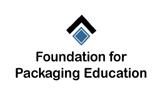

The Foundation for Packaging Education’s second fundraising event, scheduled to take place from Tuesday, July 16, 2024, to Thursday, July 18, 2024, at the luxurious Silverado Resort & Spa in the heart of Napa Valley, California, is rapidly approaching full capacity. If you’d like to join your fellow AICC members in supporting packaging education, consider the program:
• Dinner on the Napa Valley Wine Train. Embark on a memorable journey aboard the historic, meticulously restored Napa Valley Wine Train. Participants will enjoy a scenic wine country tour, indulge in a sumptuous three-course dinner, and savor exquisite wine tasting throughout the evening.
• Golf at the Silverado South Course. Golf enthusiasts can take advantage of a morning round at the Silverado South Course. Surrounded by the picturesque landscape of Napa Valley,
this experience is sure to be challenging and rewarding.
• Hands-On Cooking Experience, Lunch, and Wine Tasting at the Culinary Institute of America (CIA). Nongolfers will take in the culinary arts with a hands-on cooking experience at the renowned CIA. Following the cooking session, participants will enjoy a delectable lunch paired with exquisite wine tastings.
• Napa Valley Winery Tours, Tastings, and Lunch. Explore Chateau Montelena Winery and Beringer Vineyards during guided tours, wine tastings, and a delightful lunch. This segment of the event promises a rich and educational experience, providing insights into the art and science of winemaking.
“Don’t pass up the opportunity to spend time with friends and colleagues while
enjoying experiences in the breathtaking Napa Valley in support of the Foundation for Packaging Education,” says AICC President Mike D’Angelo. “The Foundation for Packaging Education is your future.”
Visit www.AICCbox.org/fundraiser to secure your place at this event.
For questions, contact Cindy Huber at chuber@AICCbox.org or Laura Mihalick at lmihalick@AICCbox.org or 703-836-2422.
The Foundation for Packaging Education will help create a stronger workforce in corrugated, folding carton, and rigid box manufacturing plants by funding educational opportunities throughout the industry geared toward those already employed and embarked on careers in packaging manufacturing. Invest in your future!

Regi str a t ion p en !

The International Corrugated Packaging Foundation (ICPF) is excited to announce the launch of a brand-new, user-friendly website at www.careersincorrugated.com. The website has been redesigned to better highlight ICPF’s mission, impact, and programs, while offering easy access to key employer workforce solutions and resources that connect educators and job seekers with career opportunities across this dynamic, high-tech industry.
The new website serves as a comprehensive resource hub tailored to the foundation’s many stakeholders. Key features include:
• Resources for Career Seekers: Learn more about the culture of the industry, find your unique career path in corrugated through a jobs quiz, apply for industry openings and internships on ICPF’s career portal, and more.
• Employer Workforce Solutions: Discover innovative solutions at the local, state, and national levels designed to address workforce shortages while strengthening employee recruitment and retention strategies.
• Educational Outreach Efforts: Stay informed about ICPF programs and resources that build connections with college or university, trade or vocational school, and high school educators to increase student exposure to the industry.
• How to Get Involved: Find opportunities to actively engage and contribute to growing the labor force of the corrugated packaging industry through annual fundraising events, donations, and a partnership with ICPF.
“ICPF is proud to announce the launch of this modernized, dynamic resource to increase connectivity amongst our stakeholders, while also providing a trusted landing site to educate younger generations on career opportunities within the corrugated packaging industry,” says ICPF President Caitlin Salaverria. “We’re looking forward to leveraging this resource in our work to grow the industry’s workforce by increasing awareness of the many benefits from choosing a career in the corrugated packaging industry.”
As the demand for sustainable, renewable packaging continues to rise, so do the career opportunities within the corrugated packaging industry. The new www.careersincorrugated.com is committed to empowering individuals to find rewarding jobs and lifelong careers in this vital industry.
The International Corrugated Packaging Foundation (ICPF) is excited to premiere a new corrugated packaging industry career highlight and recruitment video titled “Consider a Future in Corrugated Packaging.” The video encourages youth to consider a career in the corrugated packaging industry, highlighting the many benefits of choosing a #CareerInCorrugated.
Viewers are told the corrugated boxes they see all around them may be the key to their future. Many industry benefits, including job stability, opportunities for advancement, a commitment to sustainability, and a focus on innovation, are highlighted while showcasing the important role boxes play in our everyday
lives. The video illustrates the sense of pride that comes from making essential products used across the world. ICPF hopes students of all ages see a reflection of themselves in the video and the potential that exists for rewarding jobs and lifelong careers in the corrugated packaging industry.
“Consider a Future in Corrugated Packaging” can be used by corporate partners in industry outreach efforts to help attract talented and skilled employees to positions on the plant floor and front office. This video is the latest in ICPF’s efforts to grow the labor force of the corrugated packaging industry now and into the future. Watch the video at www.careersincorrugated.com or by scanning the QR code on this page. It will also be used in organic and paid advertising efforts across ICPF’s social media channels this spring.

Caitlin Salaverria is president of ICPF.
Scan the QR code below to watch “Consider a Future in Corrugated Packaging.”
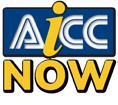


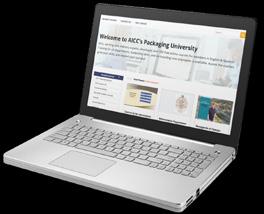
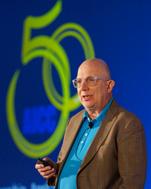

Throughout my more than 40 years in this great industry, I’ve tried to conduct myself in certain ways that have made me feel comfortable in my own skin and allowed me to sleep at night. With the advent of the internet, apps, and the like, I’ve located multiple sources that define and help me better understand, refine, and improve my philosophy and approaches.
Recently, I came across an item from Justin Wright, founder and CEO of Polished Carbon, that actually uses some of the same words I have used to describe to others how I try to behave professionally. I would like to share these with the broader AICC audience in hopes that you will see just how powerful and enabling what is today known as emotional intelligence can be. Best of all, it can be learned.
 Michael D’Angelo AICC President
Michael D’Angelo AICC President
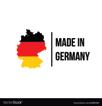
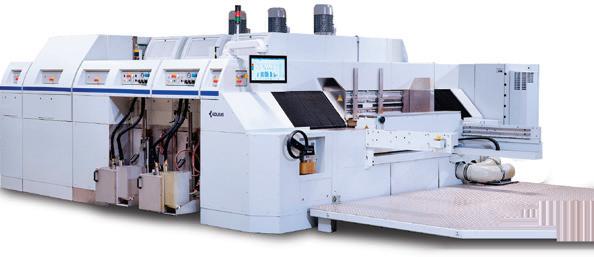

WE PROUDLY PRESENT...
The Kolbus RDG 115/135 Performance Series
We’ve combined power, precision, and performance into a robust and technically advanced machine. This hybrid-designed, gear driven rotary die cutter, has been integrated with servo technology and can be equipped with up to eight print units, a slot score unit and top print units.
Contact our sales team to learn more!
kolbusamerica.com | sales@kolbus.com | 888-705-0051




